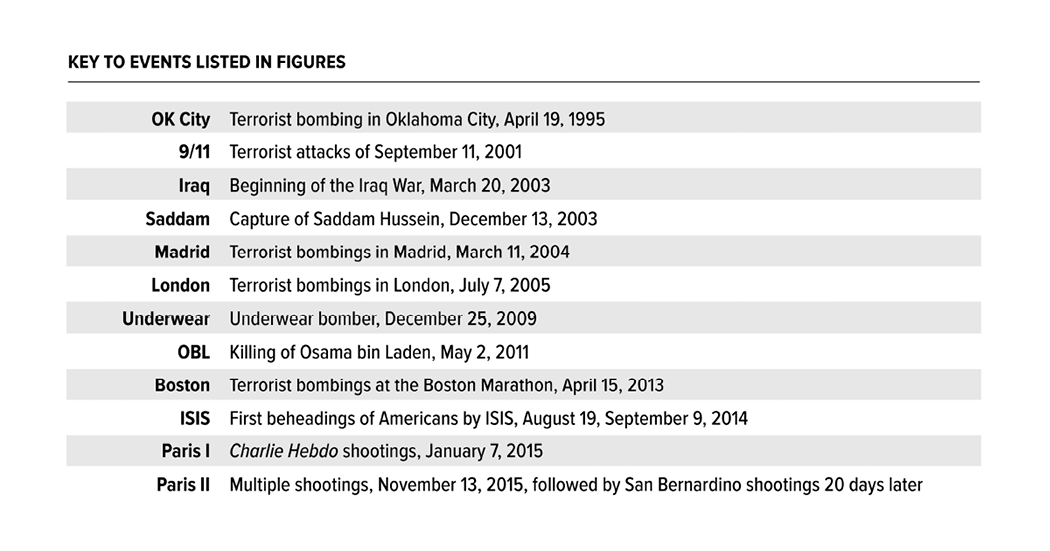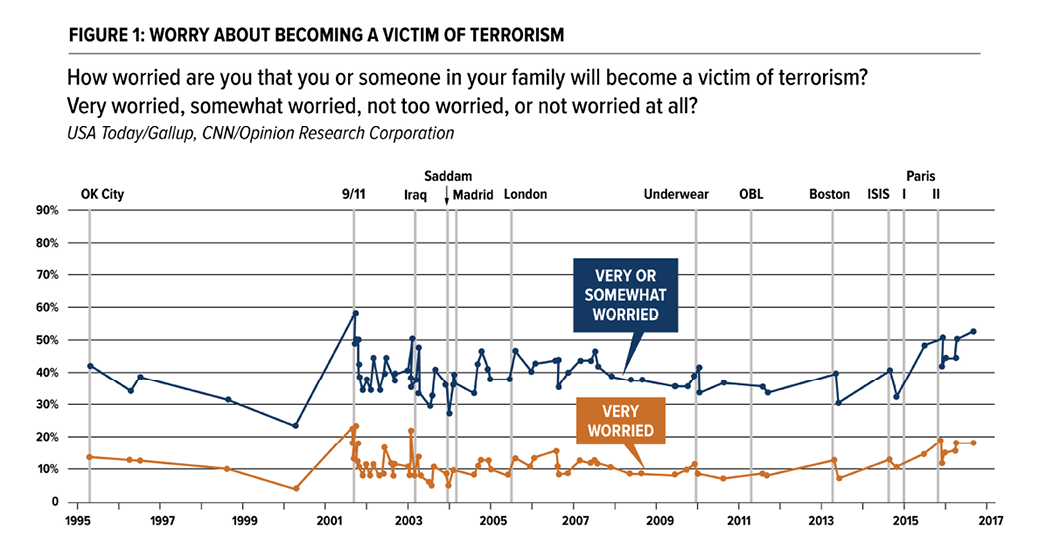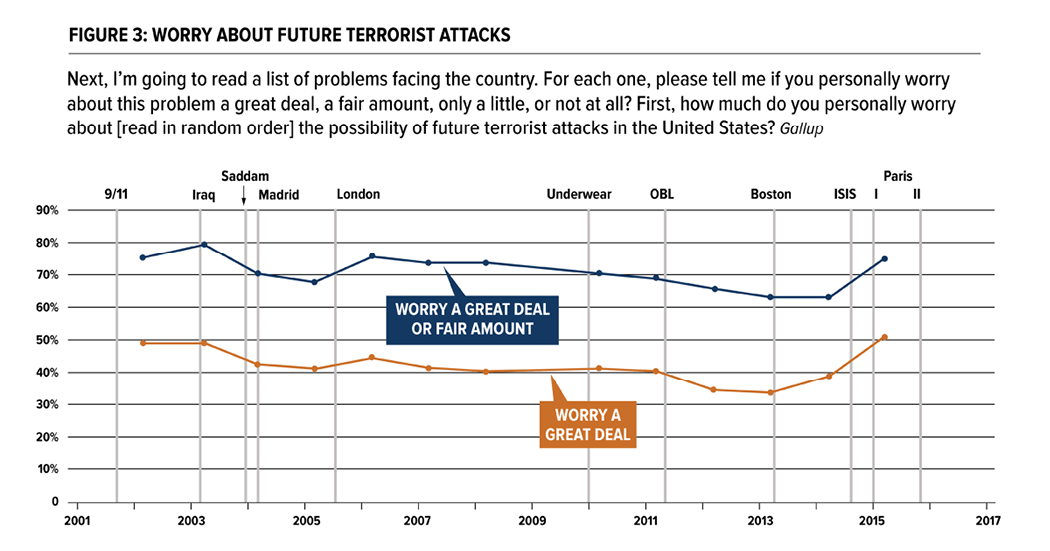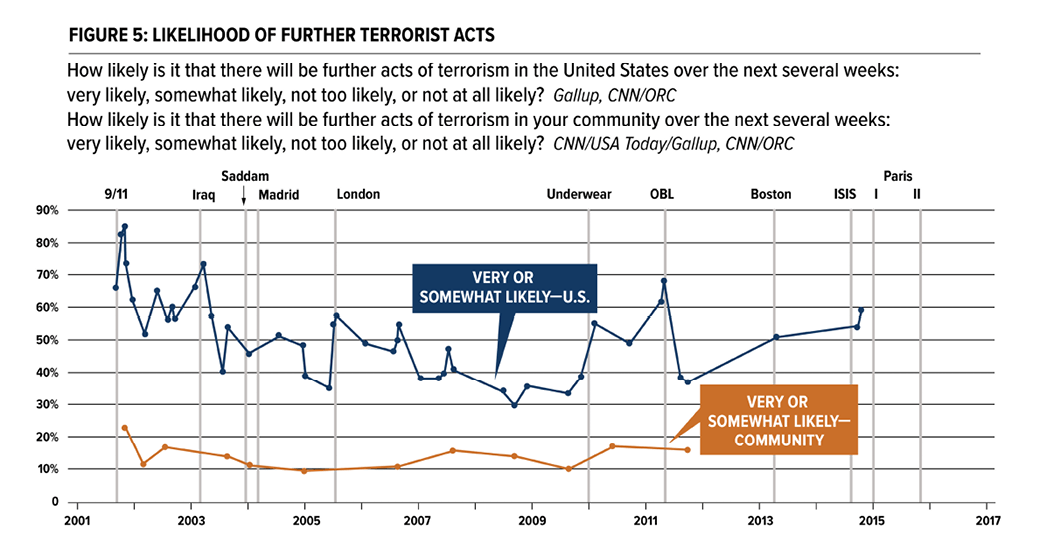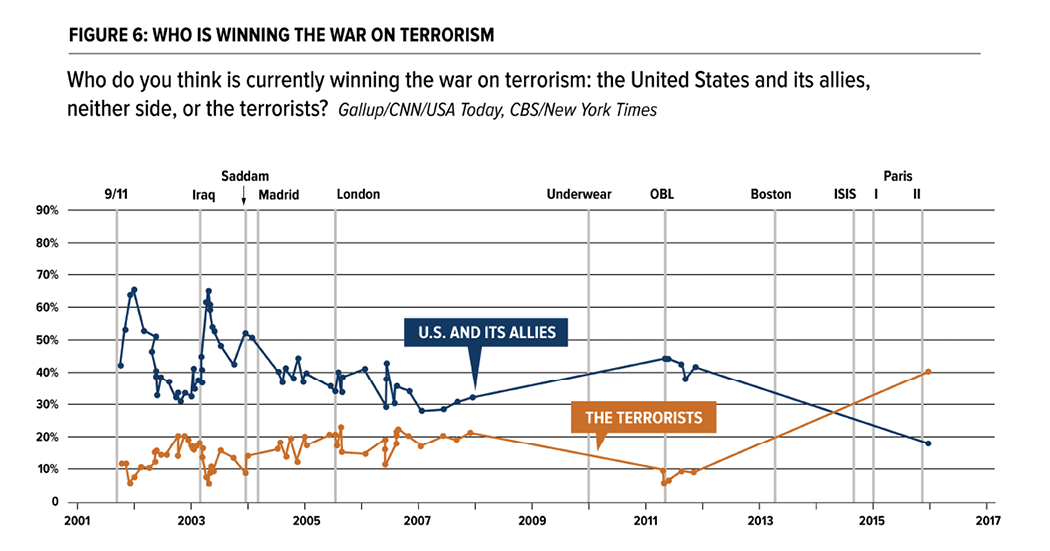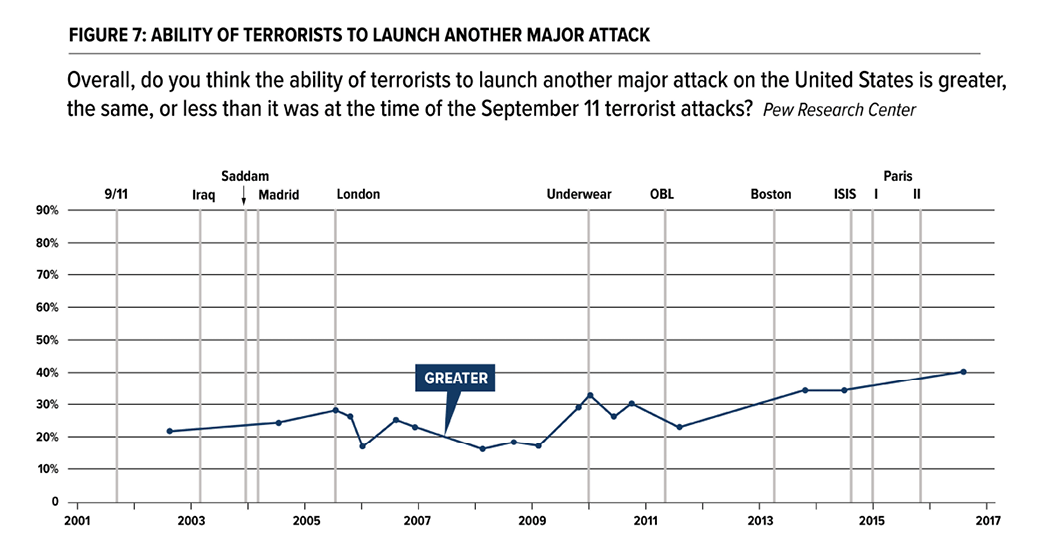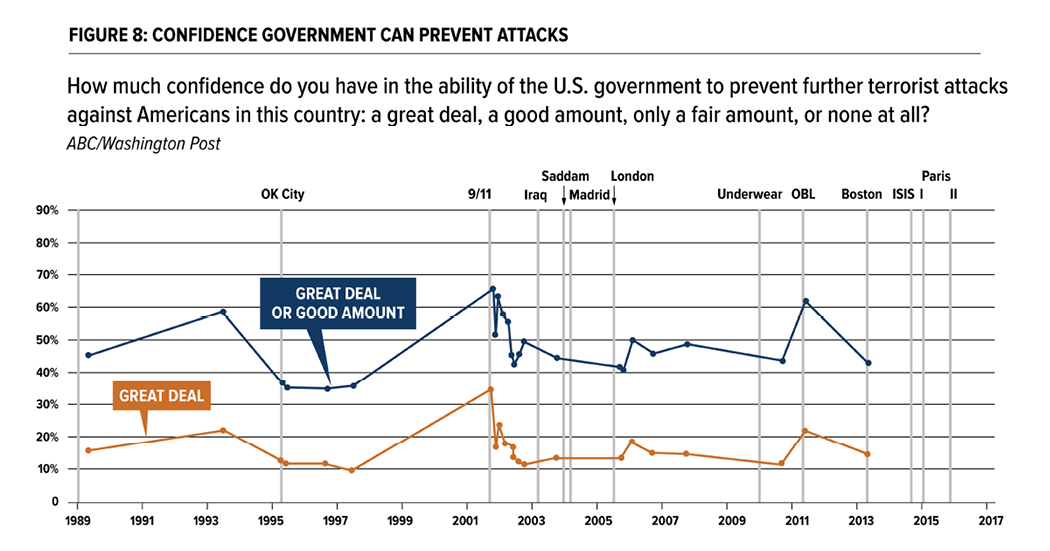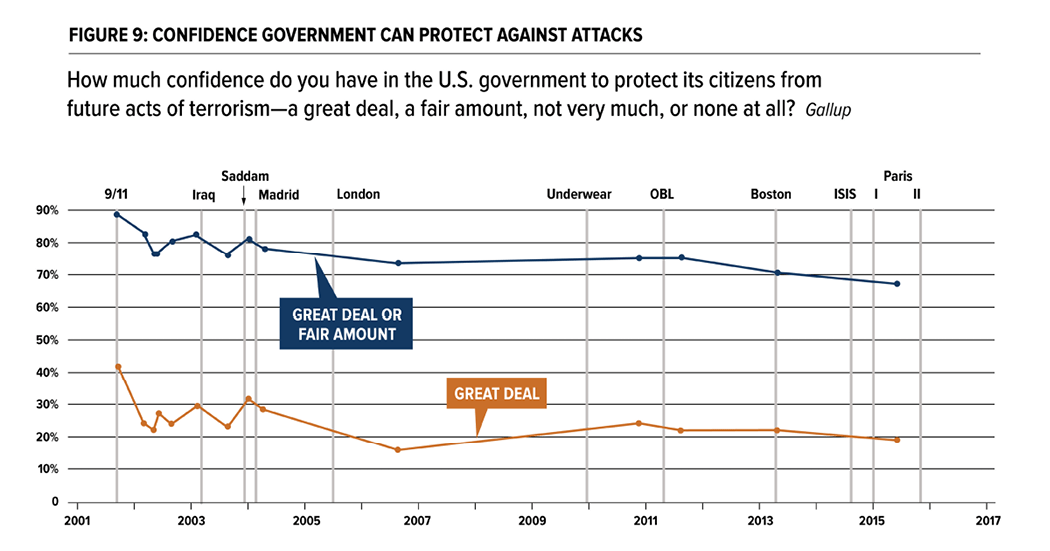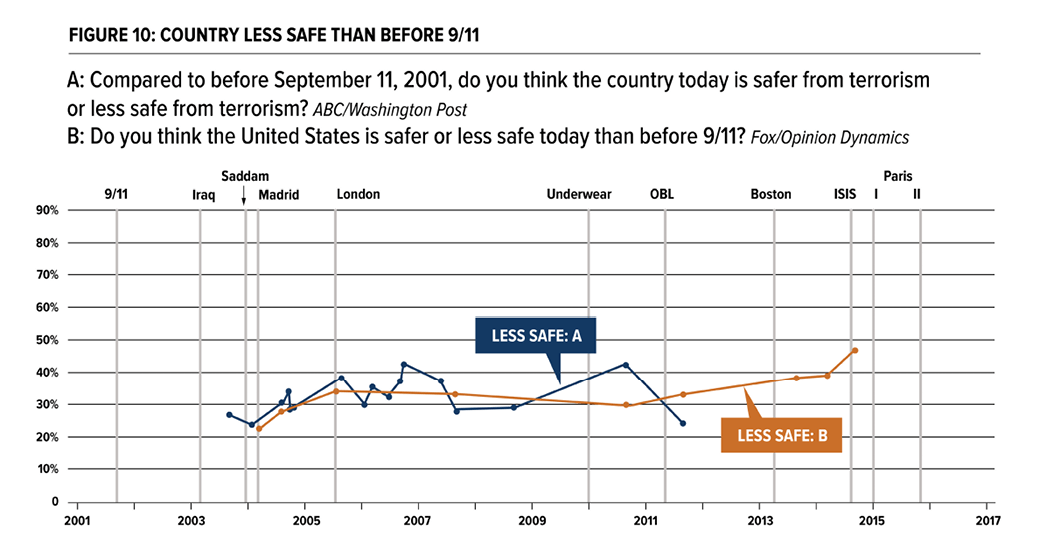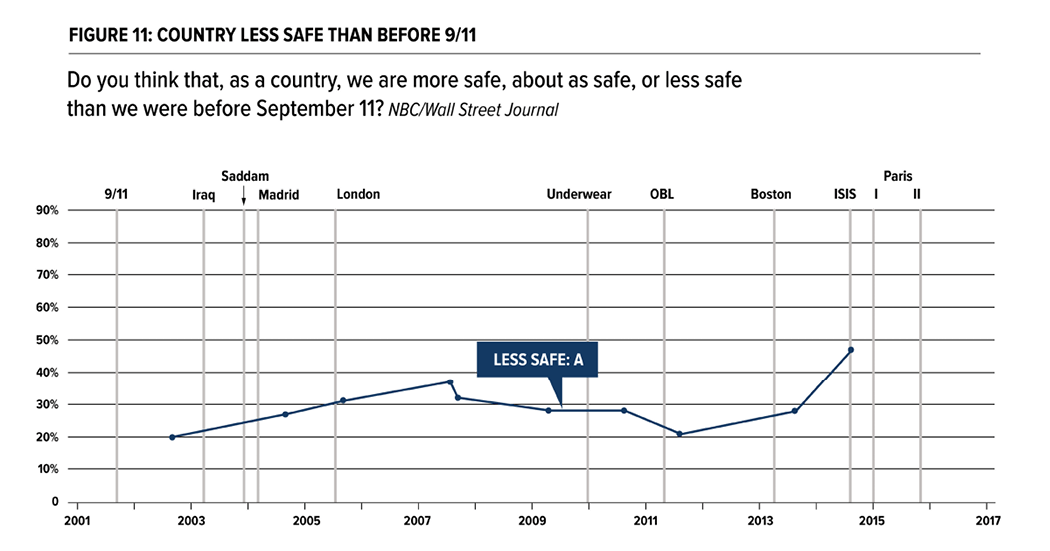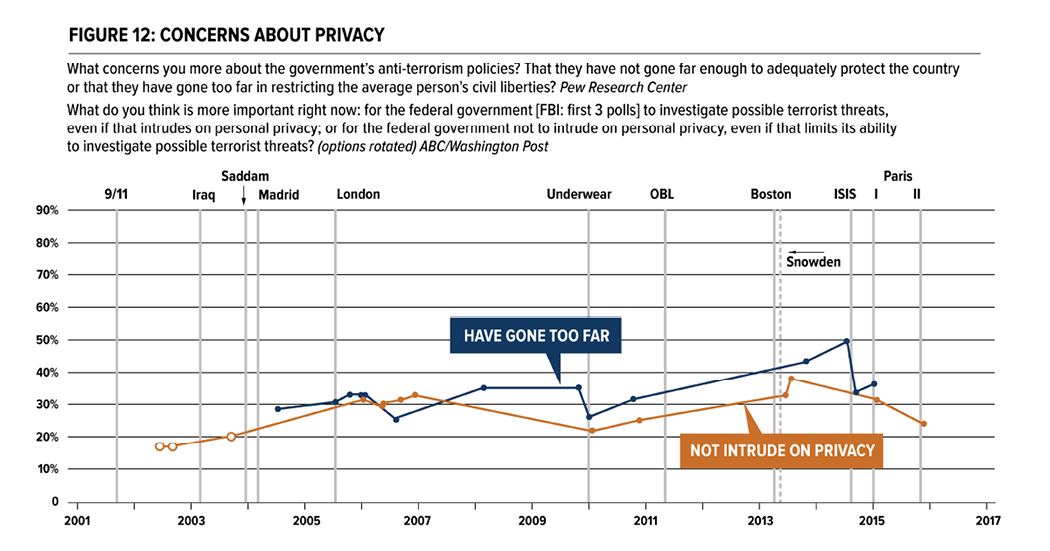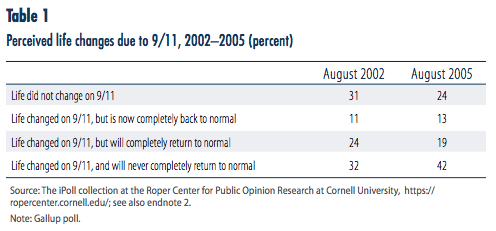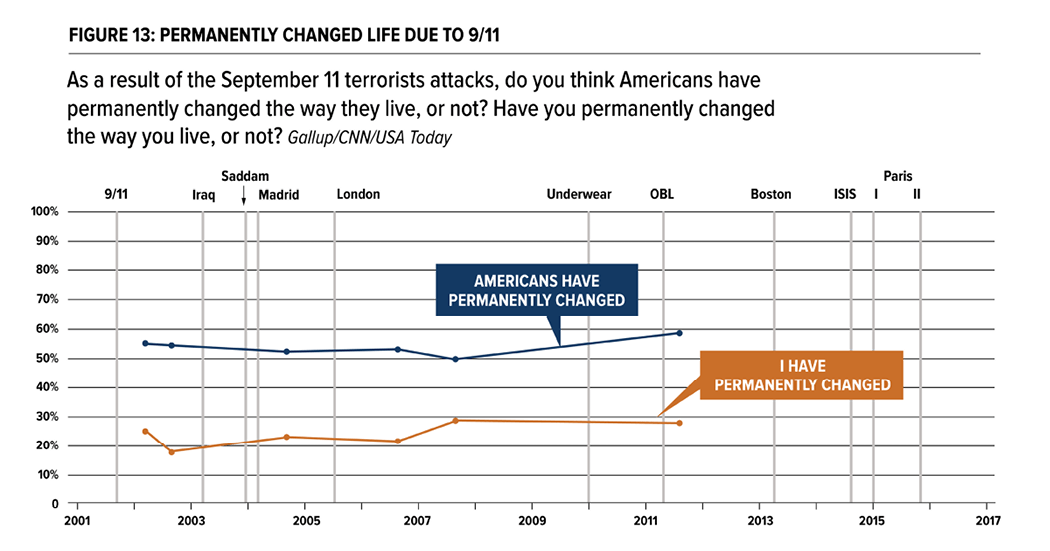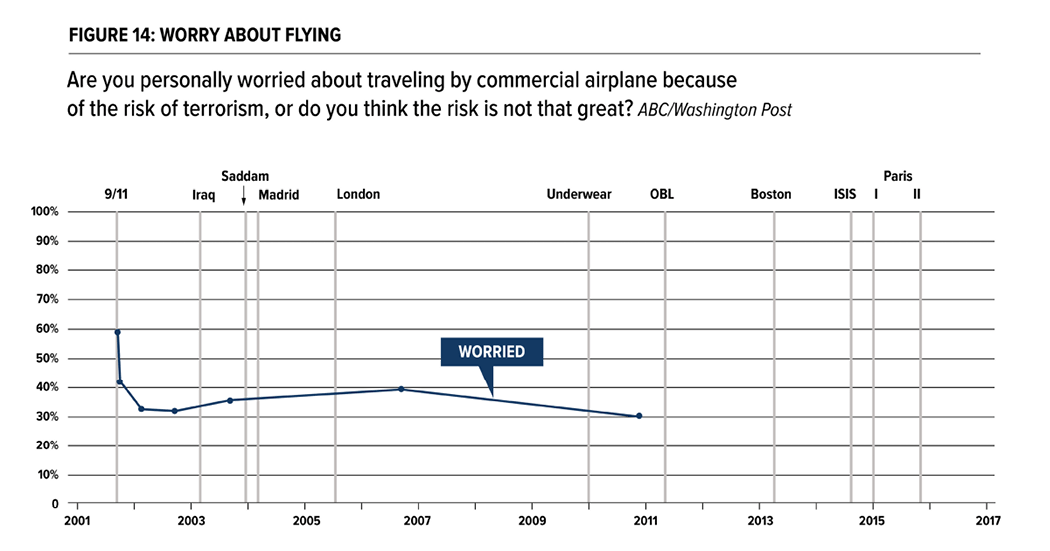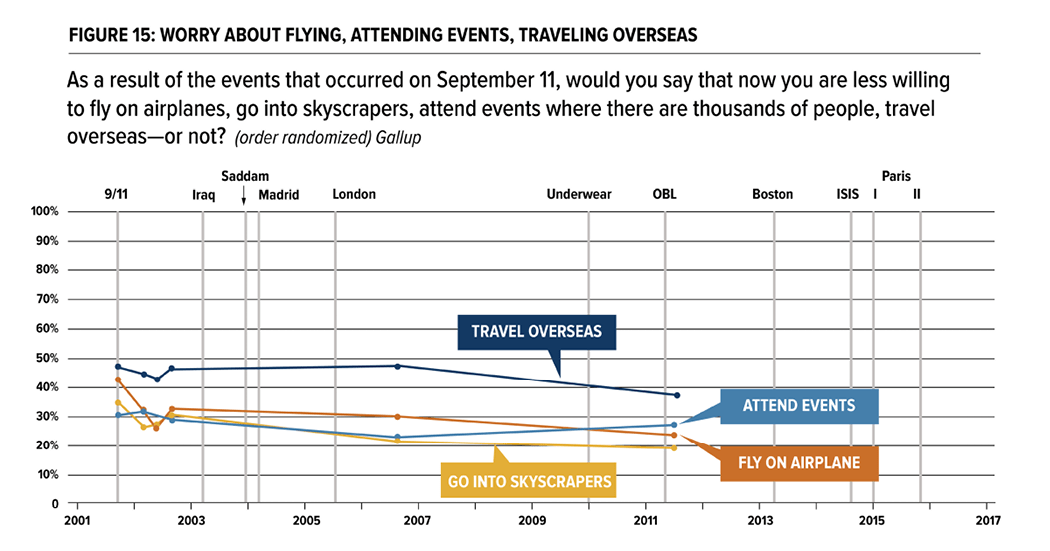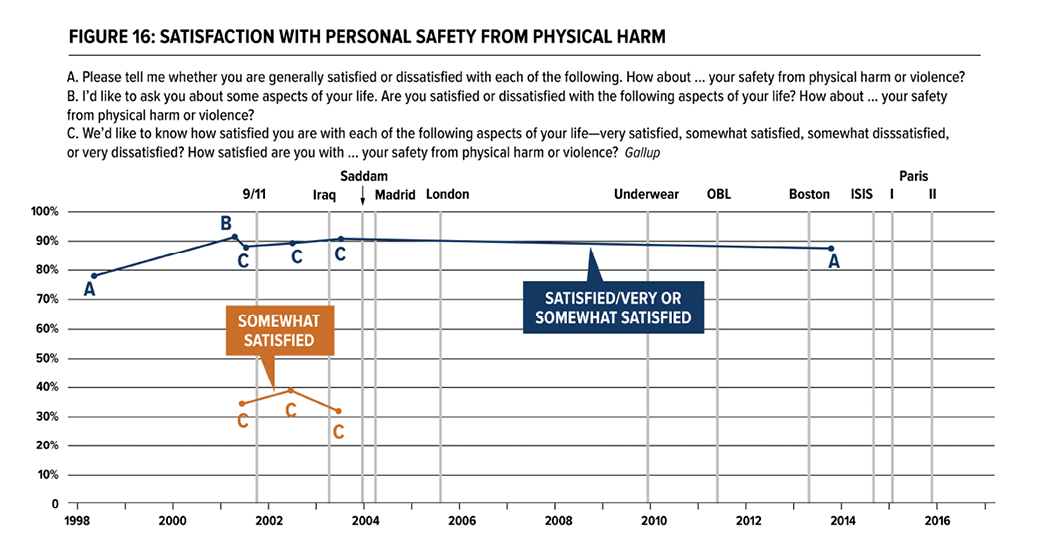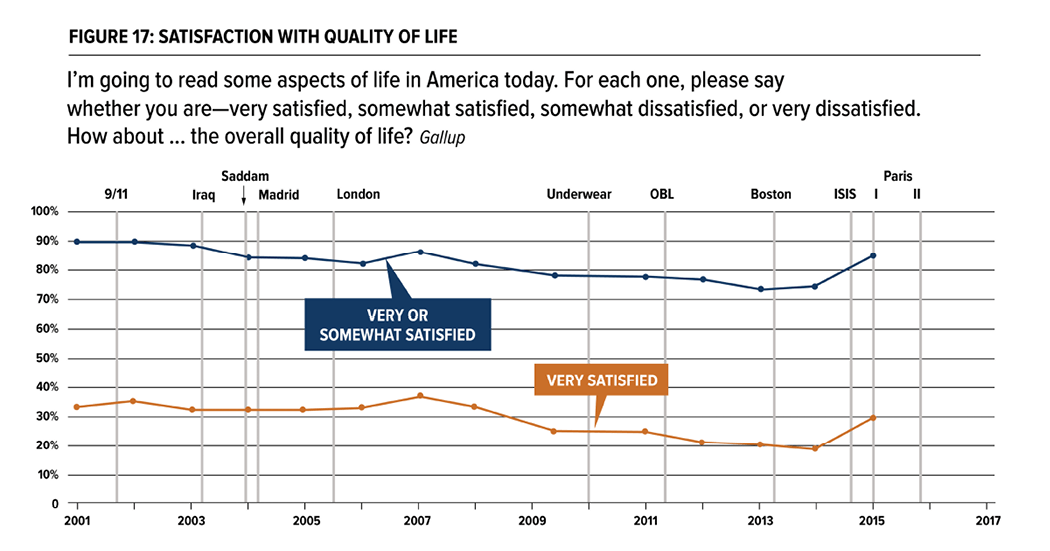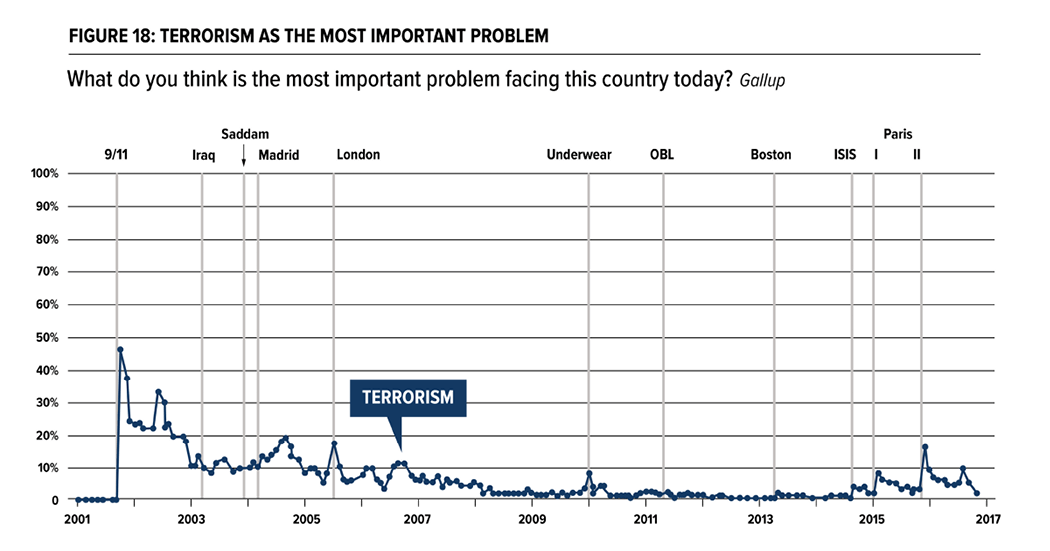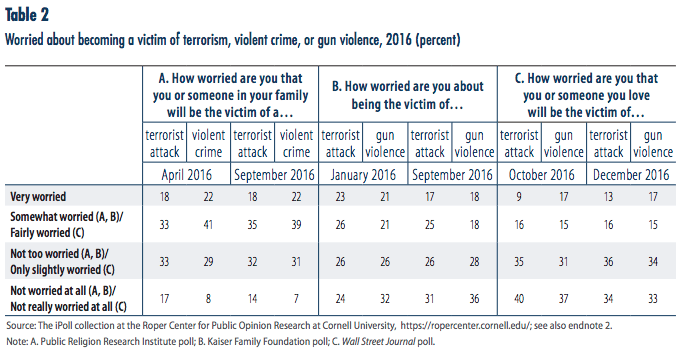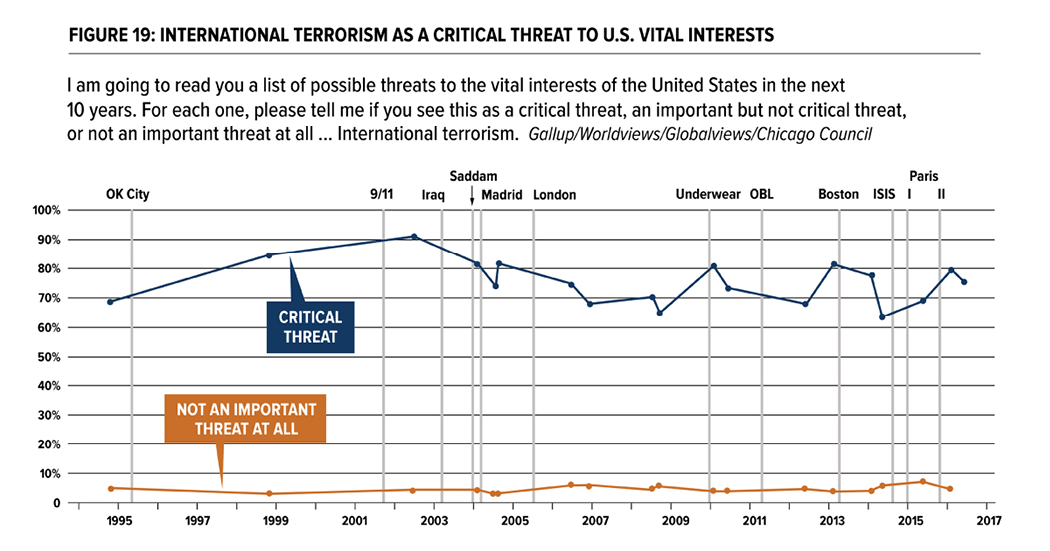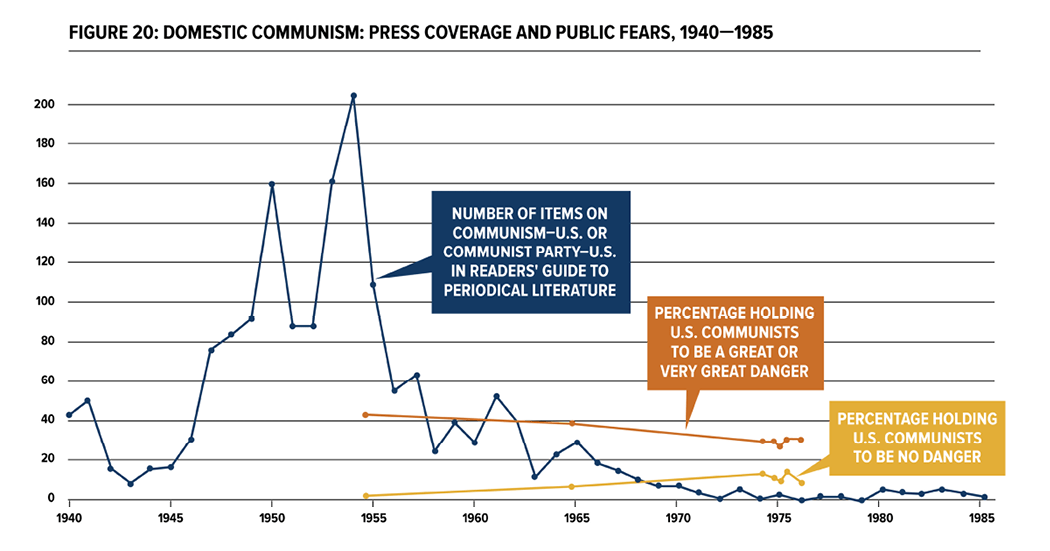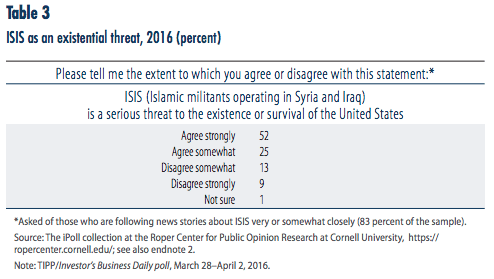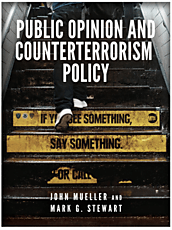Although there are multiple reasons to have expected an erosion of concern about terrorism since 2001, poll data suggest that the fear of terrorism has shown little sign of waning in the United States.
Special fear and anxiety have been stoked and maintained by the fact that Islamist terrorism seems to be part of a large and hostile conspiracy that is international in scope, and rather spooky in nature. Fear of such terrorism is more like that inspired by domestic communists during the Cold War than like that generated by domestic terrorism.
Public opinion is the primary driver behind the extensive and excessive counterterrorism efforts undertaken since 9/11, and officials and elites are more nearly responding to public fear than creating it. Policymakers can do little, if anything, to reduce the fear of terrorism—if people want to be afraid, nothing will stop them. Moreover, because of the special formlessness, even spookiness, of terrorism’s hostile foreign referent in this case, it may be exceptionally difficult to get people to believe that the threat has really been extinguished or at least that it is no longer particularly significant.
However, this means that policymakers are, in an important sense, free to do their job right: they can expend money responsibly in a manner that best saves lives rather than in one that seeks to reduce unjustified, and perhaps unfathomable, fears.
INTRODUCTION
Although there are multiple reasons to have expected an erosion of concern about terrorism since 2001, poll data suggest that much of that fright continues to linger a decade and a half later. That is, fear of terrorism has been permanent or at least perpetual. There has been a long-term, routinized mass anxiety — or at least a sense of concern — about terrorism that has shown little sign of waning since 2001, and the public has chosen to persist in what might be called a false sense of insecurity. As anthropologist Scott Atran muses, “Perhaps never in the history of human conflict have so few people with so few actual means and capabilities frightened so many.”1
It seems best to see public opinion as the primary driver behind the extraordinary counterterrorism measures adopted since 9/11. That is, the process is substantially bottom-up rather than one inspired by policymakers, risk entrepreneurs, politicians, and members of the media. They seem more nearly to be responding to the fears — playing to the galleries — than to be creating them. Since it appears that official alarmist hype was not necessary for the alarm, any decline in official and media hype is unlikely to lead to much of a decline in alarm.
This paper evaluates this rather remarkable phenomenon and considers its policy consequences. The first section examines public opinion trend data on terrorism for the United States. It shows that there has been no notable change in fears about terrorism over the decade and a half since 2001.
The second part considers a series of reasons why one might have expected to see an erosion of fear. It then sorts through a set of possible explanations for this curious pattern, stressing that special fear and anxiety seem to have been stoked and maintained primarily by the fact that Islamist terrorism has been taken to be part of a large and hostile conspiracy and network that is international in scope and rather spooky in nature. It is thus more like concerns inspired by domestic communists during the Cold War than by most traditional terrorists.
And if it is difficult to explain which events and threats will be embraced, it is even more difficult to explain how long they will linger in the public consciousness. Terrorism, like murder, has always existed in some form or other and always will. Moreover, because of the special formlessness, even spookiness, of terrorism’s hostile foreign referent in this case, it may be exceptionally difficult to get people to believe that the threat has really been extinguished — or at least that it is no longer particularly significant.
The third section explores the policy consequences. There seems to be little, if anything, policymakers can do to reduce the fear of terrorism — whether it is through shouting from the bully pulpit or through spending trillions of dollars to protect people from the feared hazard. If people want to be afraid, it seems, nothing will stop them. However, this means that policymakers are, in an important sense, free to do their job right: they can expend money responsibly in a manner that best saves lives rather than in one that seeks to reduce unjustified, and perhaps unfathomable, fears.
PUBLIC OPINION TRENDS ON TERRORISM
Poll questions specifically focused on terrorism generally find little decline since 2001 in the degree to which Americans voice concern about that hazard.2 Other issues — particularly economic ones — have often crowded out terrorism as a topic of daily concern.3 However, the 9/11 event and the fears it inspired clearly have continued to resonate in the American mind.
It does not seem that people are simply responding reflexively to the poll questions — supplying answers deemed to be socially required. Over time, the numbers on many questions have notably fluctuated in reaction to events (particularly those listed in the figures below). Thus, we see a peak and a valley, respectively, at the beginning of the war in Iraq in 2003 (when many were initially fearful that Saddam Hussein would retaliate by unleashing worldwide terrorism) and the capture of Saddam Hussein in that war (which was taken for a while to reduce the danger of terrorism). A similar effect occurred around the time of the terrorist bombings in Madrid in 2004, in London in 2005, and in Paris in 2015. The killing of Osama bin Laden in 2011 also had a temporary impact, as did the failed underwear bomber attempt at the end of 2009. And the impact of the threatening rise in 2014 of the Islamic State, or ISIS, is notable on several trend lines.
Assessing the Trends
In general, there are two patterns. On some questions, concerns about terrorism soared at the time of the 9/11 attacks, dropped to lower levels in subsequent months, but then failed to decline much further in the years thereafter. On other questions, levels of concern measured at the time of the attacks simply continued, remaining at much the same level over the subsequent decade and a half.4
The first pattern is shown in the response to the vivid, clear, and personal question displayed in Figure 1. In the immediate aftermath of 9/11, those who professed to be very or somewhat worried that they or a family member might become a victim of terrorism spiked up to 58 percent. This declined to around 40 percent by the end of 2001, a level that has held ever since.
The second pattern is displayed in Figure 2, dealing with a question about the likelihood of another terrorist attack “causing large numbers of American lives to be lost.” The percentage holding such an attack to be very or somewhat likely “in the near future” registered at over 70 percent in the aftermath of 9/11, and it was still at that level in late 2013. It spiked even higher at the time of the large terrorist attacks in London in 2005 and in Paris at the end of 2015. That pattern is traced as well in the responses to a question asking rather vaguely about the “possibility of future terrorist attacks” (Figure 3).
Figure 4 plots the results of a question about concerns over the possibility of “more major terrorist attacks in the United States.” The pattern in this case is similar to that in Figure 1: high at 9/11, then a decline by the end of the year with little change afterward. Following that pattern as well is a rather unsatisfactory pair of questions asking about the likelihood of “further acts of terrorism” (leaving the respondent to figure out what such an “act” is) over the next several weeks in the United States and in “your community” (Figure 5). The portion concerned about such “acts” taking place in their community, although relatively small, was, if anything, a bit higher in 2011 than it had often been in earlier years.
The second pattern holds for a question about whether the United States was winning the war against terrorism (Figure 6). That percentage has fluctuated, particularly in response to the war in Afghanistan that began in late 2001 and the one in Iraq that began in March 2003. However, a decade later, even after the killing of Osama bin Laden, it stood at almost exactly the same level as in October 2001. After the rise of ISIS and the terrorist attacks in Paris in 2015, responses to the question moved sharply (though possibly only temporarily) in a pessimistic direction, with more than twice as many respondents saying that the terrorists were winning (40 percent) versus those who believe the United States and its allies were (18 percent).
On a related question, the percentage maintaining that terrorists remain capable of launching “another major attack” was, if anything, higher in 2013 and 2014 (before the rise of ISIS) than it had been in 2002 (Figure 7).
The increase in spending on domestic homeland security since 9/11 has totaled well over $1 trillion, while efforts to chase down and eliminate terrorists abroad have cost trillions more.5
However, these extraordinary efforts and expenditures have utterly failed to make people feel safer. The percentage of Americans who profess to have confidence in the government’s ability to prevent further terrorist attacks was high after 9/11, when something of a “rally round the flag” effect took place (Figure 8).6 This declined thereafter but still remained in 2010 and 2013 at about the same level as in 2002. And the percentage who were confident (for the most part, only fairly so) that the government could protect them from such attacks has, if anything, waned over the decade and a half since 9/11 (Figure 9).
In addition, in 2013 and 2014 more Americans were inclined to see the country as less safe than before 9/11 than had said so a decade earlier. They became even more alarmed with the rise of ISIS (Figures 10 and 11).
The figures also demonstrate the spike-like impact some major events have on public opinion. For example, confidence in government counterterrorism efforts rose substantially at the time of the killing of bin Laden in May 2011 (Figure 8) and fears of terrorism subsided at the time, though to a lesser degree (Figure 11). However, any boost in public confidence and decline in fear evaporated within a few months (Figures 2 and 5).7
Another opinion change that has thus far proved to be temporary involves civil liberties. Edward Snowden’s startling revelations in June 2013 about the massive data collection efforts of the National Security Agency did seem to have some effect on concerns about invasions of privacy by the country’s counterterrorism enterprise. Figure 12 plots two relevant questions. In the aftermath of the Snowden revelations (which took place shortly after the Boston Marathon bombing), both poll questions moved decidedly in the direction of suggesting that the government had gone too far in restricting civil liberties and in intruding on privacy.8 Data are limited, but the top line in the figure, in particular, suggests this was no passing fancy: opinion moved considerably over the next year in the privacy/civil liberties direction. However, opinion shifted in the latter half of 2014 with the rise of ISIS. When last asked, these questions found that opinion on the issue had fallen back to levels seen during the decade prior to the Snowden disclosures.9
The Relation of Fears of Terrorism to Behavior and to Other Fears and Concerns
In general, the impact of terrorism on actual behavior, as opposed to opinion as registered in polls, seems to have been fairly minor.10 The 9/11 tragedy did, of course, have a notable effect on the U.S. economy, on tourism, and especially on air travel, and full recovery took more than three years — during which time hundreds were killed because they drove to their destinations to avoid flying.11 Meanwhile, however, property values in the targeted cities of New York and Washington continued upward. Eventually, like other cities, they declined, but this was caused by the recession that began in 2008, not by fears of terrorism.
The impact of other terrorist events on behavior in the United States does not seem to be very considerable even for the worst of these, the killing of 49 people at a nightclub in Orlando, Florida, in 2016. More generally, an exhaustive review of international terrorism losses by Todd Sandler and Walter Enders concludes that “for most economies, the economic consequences of terrorism are generally very modest and of a short-term nature” and “large diversified economies are able to withstand terrorism and do not display adverse macroeconomic influences.” Moreover, most effects are localized.12
Nonetheless, considerable numbers of Americans claim that terrorism has affected their behavior. Since 2002, around a quarter of them have maintained that it has permanently changed the way they live (Figure 13), and more people in 2005 than had done so in 2001 said that life would never completely return to normal (Table 1). In another poll, reported worries about flying because of the risk of terrorism registered at about the same level in 2010 as in 2002 (Figure 14). And a considerable minority say that, as a result of 9/11, they are less willing to fly on airplanes, go into skyscrapers, travel overseas, or attend events where there are thousands of people (Figure 15). These percentages did not change much at all in the decade after 2001.
However, 9/11 did not cause Americans to fear for their personal safety more generally — satisfaction levels on that score were remarkably high before the attacks and have remained so since (Figure 16). Presumably, absent a specific reference to terrorism in this set of questions, respondents mostly thought about crime.
Nor did 9/11 change the degree to which Americans judged their overall quality of life to be satisfactory — although this did decline in later years in response, presumably, to the economic recession that began in 2008, only to rise again when the recession waned (Figure 17). The percentage of Americans who were very or somewhat satisfied with the “overall quality of life” remained between 81 percent and 89 percent from 2001 to 2008.
In contrast, studies in Europe suggest that terrorism can affect people’s sense of life satisfaction, or their self-reported subjective well-being scores, and that these changes can have substantial economic consequences.13 This effect does not show up in the American data, perhaps because the European studies concentrate on places like Northern Ireland, where terrorist violence was continual and more focused and thus presumably heightened actual anxiety and affected daily existence more. By contrast, terrorism in the United States since 9/11 has been not only sporadic (and rare), but effectively random. Accordingly, there is little anyone can do about it, except perhaps worry. In particular, moving to get away from it makes little sense, whereas moving out of high-crime neighborhoods (or back to them when crime there seems to subside) does.
Although Americans may profess to worry about terrorism and feel no safer from it than they did before 9/11, terrorism has dropped considerably in the degree to which it registers on questions about the most important problem facing the country today. As Figure 18 indicates, there were some upward spikes in concern at the time of official warnings in the run-up to the 2004 election about an imminent attack, and at the time of the terrorist attacks in London in 2005, the attempted attack by the underwear bomber in 2009, and the rise of ISIS in the last few years. However, the percentage of Americans who counted terrorism as the country’s “most important problem” has not registered above 20 percent since 2002. Other concerns — the wars in the Middle East and, more recently, the economy — have dominated the responses to this question.14
EXPLAINING AND EVALUATING THE TRENDS
In July 2014, on the 10th anniversary of the 9/11 Commission Report, the commission’s chair and vice chair voiced concern that “complacency is setting in.” Americans were exhibiting “counterterrorism fatigue” about the “evolving,” “grave,” and “undiminished” danger that, the commissioners insisted, terrorism continued to present, and they espied a “waning sense of urgency.”15 However, as we have seen, there is little evidence from the polls to support such a conclusion: concern about terrorism has not waned.16
Anticipating Erosion
This is rather surprising because there is reason to have expected that, however traumatic the initial experience of 9/11, concerns and anxieties about terrorism would have begun at least to wane over time.
To begin with, objectively speaking, there is little reason to fear terrorism. It was on February 16, 2003 — a decade and a half ago — that filmmaker-provocateur Michael Moore happened to remark on CBS television’s 60 Minutes that “the chances of any of us dying in a terrorist incident is very, very, very small.” His interviewer, Bob Simon, promptly admonished, “But no one sees the world like that.” Remarkably, both statements were true then, and continue to be so today.
The overall probability that an American will be killed by a terrorist (whether Islamist or not) in the United States during the last half century stands at about one in 4 million per year. For the period since 2001, the concern of this paper, the odds are far lower — something like one in 50 million per year. By comparison, an American’s chance of being killed in an automobile crash is about one in 8,200 a year, while the chance of becoming a victim of homicide is about one in 22,000. Even the chance of drowning in a bathtub (one in 950,000) or the chance of being killed by an accident-causing deer (one in 2 million) is higher than that of being killed by a terrorist. Since 9/11, the number of Americans killed by Islamist terrorists is six per year.17
Yet, as shown in Figure 1, some 40 percent of the public continues to say when polled that they worry that they or a family member will become a terrorist victim, a number that has scarcely changed since late 2001. And the percentage holding the country to be less safe than before 9/11 did not move much in the decade after the 9/11 Commission issued its report in 2004 (Figures 10 and 11).
Some direct comparisons are possible. In Table 2, worries about being a victim of a terrorist attack are compared to worries about being a victim of violent crime and of gun violence. Even though an American’s chance of being killed in a criminal homicide or by gun violence is far higher — something like one chance in 20,000 per year rather than one chance in 4 million — worry levels as measured in these polls are much the same.18
Another reason to have expected a degree of erosion is that terrorism has proved to be far less of a hazard than was feared in the immediate aftermath of 9/11. Reflecting back four years after the event, former New York mayor Rudy Giuliani recalled that “anybody — any one of these security experts, including myself — would have told you on September 11, 2001, we’re looking at dozens and dozens and multiyears of attacks like this.”19 And journalist Jane Mayer observed that “the only certainty shared by virtually the entire American intelligence community in the months after September 11 was that a second wave of even more devastating terrorist attacks on America was imminent.”20
However, such plausible, if alarmist, anticipations have fortunately failed to be realized, and the 9/11 attack stands out as an aberration. Before or after, there has scarcely ever been a terrorist act, inside or outside a war zone, that inflicted even one-tenth as much total destruction.21
In fact, not only has there been no repeat of 9/11, but, although al Qaeda, ISIS, and their various affiliates have served as inspiration for some jihadists in the United States, these groups have failed on their own to directly consummate any attack of any magnitude whatsoever on American soil — or, for that matter, in the air lanes approaching it.
Al Qaeda Central appears to consist of perhaps one or two hundred people. Judging from information obtained from Osama bin Laden’s lair after he was killed in Pakistan in May 2011, the few remaining al Qaeda fighters have been primarily occupied with dodging drone missile attacks, complaining about their lack of funds, and watching a lot of pornography.22 Al Qaeda has served as something of an inspiration to some Muslim extremists, has done some training, seems to have contributed to the Taliban’s far larger insurgency in Afghanistan, and may have participated in a few terrorist acts in Pakistan. In his examination of the major terrorist plots against the West since 9/11, Mitchell Silber finds only two — the shoe bomber attempt of 2001 and the effort to blow up transatlantic airliners with liquid bombs in 2006 — that could be said to be under the “command and control” of al Qaeda Central (as opposed to ones suggested, endorsed, or inspired by the organization), and there are questions about how full its control was even in these two instances, and, of course, both of these failed miserably.23 Al Qaeda has also issued videos filled with empty, self-infatuated, and essentially delusional threats.24
The killing of bin Laden in May 2011 might have been expected to help the public to relax a bit on the terrorism issue. But this has not occurred. At the time of bin Laden’s killing, there was an abrupt increase in the percentage having confidence in the government’s ability to prevent further terrorist attacks (Figure 8). But that effect fully evaporated by the time the question was next asked (see also Figures 2 and 5). The reaction of the CIA’s Michael Morell captures the public mood. He recalls that, at the time of the raid, he “felt closure for the first time since 9/11.” However, that feeling clearly didn’t last; he soon came to believe that “the war against Islamic extremism was far from over” and would have to be fought by “multiple generations.”25 Groups in Iraq, Syria, Yemen, Libya, and Nigeria that have variously been affiliated with al Qaeda have done considerable damage in connection with ongoing civil wars, but little to the “far enemy,” which is al Qaeda’s stated central goal.26 For the most part, they haven’t even tried.27
And the Islamic State now exhibits the same defects as the group from which it emerged, the al Qaeda branch in Iraq. As Middle East specialist Ramzy Mardini observed in 2014, its “fundamentals are weak”; “it does not have a sustainable endgame”; its “extreme ideology, spirit of subjugation, and acts of barbarism prevent it from becoming a political venue for the masses”; its foolhardy efforts to instill fear in everyone limit “its opportunities for alliances” and make it “vulnerable to popular backlash”; “its potential support across the region ranges from limited to nonexistent”; and it “is completely isolated, encircled by enemies.”28 In particular, ISIS’s brutalities, such as staged beheadings of hostages, summary executions of prisoners, and the rape and enslavement of female captives, have greatly intensified opposition to the group. As Georgetown University’s Daniel Byman notes, it has shown a “genius for making enemies” and has been incapable of making common cause even with other Sunni rebel groups, and, by holding territory, has presented an obvious and clear target to military opponents.29
Mardini’s observations have proved prescient. After the heady days of 2014 and early 2015, ISIS’s advances have been forcibly stopped and then reversed in its main base areas in the Middle East.30 As this was happening, ISIS decided to exact revenge and to remind the world of its continued existence by launching sporadic and vicious terrorist attacks in the Middle East and by inspiring them abroad in any country at all, not just countries participating in the fight against ISIS.31 Thus, ISIS has claimed responsibility for — or, more accurately, boorishly celebrated — terrorist attacks abroad, such as those in Paris, Brussels, Nice, Munich, Berlin, London, Manchester, and Barcelona. But there is little indication that ISIS Central planned or significantly participated in them.32
In addition, despite extensive fears, no al Qaeda or ISIS cells have appeared in the United States.33 Among the over two billion foreigners who have entered the United States legally since 9/11, one would think they could have smuggled in a few operatives at least.34
Fears about terrorism might also have been expected to decline because the homegrown terrorist “plotters” who have been apprehended have mostly proved — while perhaps potentially somewhat dangerous at least in a few cases — to be amateurish and almost absurdly incompetent. Brian Jenkins’s summary assessment is apt: “Their numbers remain small, their determination limp, and their competence poor.”35
Also relevant is that there have been so few terrorist attacks from any source in the United States. Indeed, since 9/11, Islamist extremist terrorists (none of them directly linked to al Qaeda or ISIS, except in some cases by inspiration) have managed to kill a total of about 100 people in the United States or, as noted earlier, some 6 per year.36 In addition, during the same period about half that number have been killed by right-wing terrorists.37 Considerably more people have been killed by deranged nonterrorists in various individual shootings at schools and theaters.
Shifting the focus to other countries in the developed world, there were remarkably few major attacks during the decade after 2005. Sizeable terrorist attacks — ones that kill at least 25 people — were visited upon domestic transportation systems in Madrid in 2004 and London in 2005, killing 191 and 52, respectively.38 The next attack of that magnitude anywhere in the developed world occurred over a decade later in a set of shootings that took place in Paris in November 2015 in which 130 were killed. One might expect that public concern about terrorism would have shown signs at least of waning over the long interval between those attacks. But it didn’t.39
Erosion of fear might also have been expected because official and media alarmism on the issue has declined at least somewhat over the years. To be sure, U.S. government officials have maintained their willingness and ability to stoke fear about the “persistent” and “evolving” threat.40 However, explicit predictions that the country must brace itself for a large imminent attack, so common in the years after September 11, are now rarely heard.41 In addition, media attention to terrorism has generally declined over most of the period since 9/11, although that changed somewhat after the dramatic and attention-arresting rise of ISIS in 2014. The general decline in interest is suggested in the data in the figures: polling agencies have substantially reduced the frequency with which they have polled on the terrorism issue over the years. It even seems possible — though it is difficult to be certain — that there has been something of a decline in concern that terrorists will get weapons of mass destruction, or at least nuclear ones, a major preoccupation for several years after 9/11.42
There are two other reasons to have expected a decline in concern about terrorism. First, huge increases in counterterrorism efforts and spending might have had some reassuring effect. Since 9/11, as noted earlier, expenditures on domestic homeland security against terrorism have grown by well over $1 trillion. And more trillions have been spent on counterterrorism wars in the Middle East in order “to defeat them abroad before they attack us at home,” as President George W. Bush put it in 2005.43 Former National Security Agency director Michael Hayden recalls a dictum he issued two days after 9/11: “We were going to keep America free by making Americans feel safe.”44 America has, it seems, pretty much remained free, but the polls strongly suggest it is not because Americans have come to feel safe.
And second, it is rather easy to register a change of opinion in polls. Most questions give those polled a response range with gradations that should facilitate a change if one is so inclined. For example, respondents are not obligated to choose between deeming another terrorist attack to be either likely or unlikely. Rather, they can go from “very likely” to “somewhat likely” or from “somewhat likely” to “not too likely.” For the most part, they have declined to do so, at least in the aggregate. Explaining the Absence of Decline On some poll questions, anxieties about the threat presented by terrorism declined in the weeks after the 9/11 attacks, while other poll questions have shown no decline whatsoever. The substantial absence of decline on nearly all questions in the subsequent years is quite impressive given the many reasons to have expected Americans to have become less fearful.
Several factors may help to explain this puzzling phenomenon. The persistence of anxieties about terrorism among Americans doubtless stems importantly from the peculiar, outsized trauma induced by the 9/11 attacks. And it is possible that this initial alarm was importantly reinforced or reified by the (unrelated) anthrax attacks that followed shortly after.45 Two other events that took place in late 2001 may also have reinforced alarm. One was an airliner crash in New York on November 12 that was at first commonly taken to be caused by terrorism, a conclusion that turned out not to be true. The other was the bungled effort of the shoe bomber to blow up a flight from Paris to Miami on December 22.46
However, if September 11 is an aberration, as it increasingly appears, it would seem to follow that the experience might gradually come to be seen as a tragic outlier, not one that fundamentally determines consequent activities, perceptions, planning, and expenditures. But that has not happened.
There might also be an effect from some continued resonance of the extrapolation holding that, because the 9/11 terrorists were successful with box cutters, they might soon be able to turn out weapons of mass destruction and then detonate them in an American city.47 In fact, terrorists have been unable to fabricate much in the way of chemical weapons, much less nuclear ones.48
Anxiety may also derive from the perception that Muslim extremist terrorists, like those of 9/11, seem to be out to kill more or less at random. In some respects, fear of terrorism may be something like playing the lottery except in reverse. The chances of winning the lottery or of dying from terrorism may be microscopic, but for monumental events that are, or seem, random, one can conclude that one’s chances are just as good or bad as those of anyone else. As Cass Sunstein notes:
Those who operate gambling casinos and lotteries … play on people’s emotions in the particular sense that they conjure up palpable pictures of victory and easy living, thus encouraging people to neglect the question of probability. With respect to risks, insurance companies, extreme environmental groups, and terrorists do exactly the same.49
The fact that Muslim terrorists seem to want to kill as many people as possible also impresses. Many terrorists, it is true, are mainly out to draw attention to their cause and to focus on specific and predicable targets and have no desire to create mass casualties. Noting that the scale of the September 11, 2001, attacks has “tended to obliterate America’s memory of pre‑9/11 terrorism,” Brian Jenkins reminds us that:
measured by the number of terrorist attacks, the volume of domestic terrorist activity was much greater in the 1970s. That tumultuous decade saw 60 to 70 terrorist incidents, mostly bombings, on U.S. soil every year — a level of terrorist activity 15 to 20 times that seen in the years since 9/11… . [Terrorists] hijacked airliners; held hostages in Washington, New York, Chicago, and San Francisco; bombed embassies, corporate headquarters, and government buildings; robbed banks; murdered diplomats; and blew up power transformers, causing widespread blackouts.
However, continues Jenkins, in the hundreds of terrorist incidents in the United States that took place during the 1970s, only 72 people perished.50 In that era, he recalls, he concluded that “terrorists want a lot of people watching, not a lot of people dead.”51 By contrast, Islamist terrorism in the United States both before and after 9/11 (as, for example, in the failed World Trade Center attack of 1993) has been committed to killing as many people as possible and effectively in a random manner. And the handful of successful attacks that such terrorists have pulled off in the United States in the decade and a half since 9/11 have killed more people than perished in all the hundreds of attacks of the 1970s. Yet, reticence about killing and randomness about doing so does not characterize all non-Muslim terrorism. Timothy McVeigh, who perpetrated the 1995 Oklahoma City bombing that resulted in 168 deaths — the second-most-destructive terrorist act ever in the United States and one of the worst in history — was clearly out to kill a large number of people and to do so essentially randomly. He was determined to blow up a government building and scouted in five states before settling on the one in Oklahoma City. He attacked during business hours and had no concern about who might happen to be in the building at the time. Yet, as will be discussed more fully later, this case did not lead to perpetual fear in the way Islamist terrorism has.
The seemingly constant stream of well over 100 small-time terrorism cases that have come to light in the United States since 9/11 may have kept the pot boiling. These include terrorist plots, or proto-plots, in which Islamists, whether based in the United States or abroad, have planned, or appear to have planned, to attack targets in the United States.52 And they also include an equal or somewhat larger number of cases in which individuals have been apprehended in the process of seeking to go abroad to fight against America or American interests there, particularly in Iraq or Afghanistan, and later in Syria.53 Although few of these have generated much in the way of lasting media interest, the fairly relentless drumbeat of these cases may have had an effect by continually reminding people that there are still terrorists out there.54 The stress on what these failed (and mostly boneheaded) plotters hoped to do (destroy the Brooklyn Bridge, the Sears Tower, the U.S. Capitol building), rather than on what they were actually likely to be able to do, probably has also contributed to high levels of public fear.55 Of course, it is also possible that the continual reminders could have inspired a numbing “cry wolf” effect. But this does not appear to have happened.
In addition, there is some reason to believe that, although noticeable security measures like armed guards, high walls, and barbed wire make people feel less vulnerable to crime, these same devices can make people feel tense, suspicious, and fearful when they are instituted in the context of dealing with the threat of terrorism.56 Conceivably, even occasionally seeing Muslim women in headscarves may serve as a continuing semiconscious reminder. The phenomenon is suggested as well by some experiments conducted by Clem Brooks and Jeff Manza. “Getting people to think about the specter of terrorism,” they conclude, “tends to bolster anew their willingness to support coercive new measures” and generates “a nearly automatic response and demand for coercive policies,” a process that is most pronounced among those “who come into the survey worried about terrorism.”57
However, the remarkable absence of erosion in concern seems most plausibly explained by the notion that special fear and anxiety have been stirred because Islamist terrorism is seen to be part of a large and hostile conspiracy that is international in scope and rather spooky.58 In the words of Brooks and Manza, it is seen to be a “subversive enemy” that is “foreign in origin but with possible domestic supporters organized in covert cells, hidden yet seemingly everywhere, and providing a direct and open challenge to American democracy and capitalism.”59
As noted above, there were hundreds of terrorist attacks in the 1970s, but these did not inspire great anxiety. This seems to be because they were mainly domestic in apparent origin and scope: for the most part, they did not have a significant foreign or external referent. This holds true even for domestic attacks that are highly destructive. In the aftermath of the 1995 Oklahoma City attack, over 40 percent of respondents said they worried about becoming a victim of terrorism, as can be seen in Figure 1. However, this percentage declined considerably in the next few years. The same pattern is suggested in Figure 4: the decline in concern about terrorism between 1995 to 1997 it documents would likely have continued over the next few years.
Also suggestive are the results generated by a poll question that seeks to tap the public’s concern about the threat presented by international terrorism (as opposed to domestic terrorism) to the vital interests of the United States (Figure 19). Although the number of those holding international terrorism to be a “critical threat” rose notably in the immediate aftermath of 9/11, the percentage holding this view has been very high ever since pollsters started asking about it in 1994, and it has remained high over the years after 9/11, even before the rise of ISIS.60 And at no time has more than 4 percent of the public deemed international terrorism to be “not an important threat at all.”
Comparing Fear of Terrorists with Fear of Domestic Communists (and Witches)
A potentially instructive comparison is with concerns about domestic communists during the Cold War. In the few years after World War II, alarm about the threat presented by such “enemies from within” grew with two spectacular espionage cases. First, a respected former State Department official, Alger Hiss, was accused of having sent huge quantities of classified documents to the Soviets before World War II. Then, a former communist, British physicist Klaus Fuchs, admitted that he had sent atomic secrets to the Soviets, and the trail from Fuchs soon led to the arrests of various coconspirators and ultimately to the celebrated trial of two American communists, Julius and Ethel Rosenberg, who were convicted of being atomic spies and then executed. This experience was set in high relief with the invasion of South Korea by forces from communist North Korea in June 1950, bolstered later in the year by hordes of troops from communist China. Almost everyone simply assumed that the Korean War was being directed from Moscow and was part of a broad militarized quest for “world domination.”61
Similar to the concern that Islamist terrorists are within our midst was the concern of many Americans that domestic communists were connected to and agents of a vast, foreign-based conspiracy to topple America. Extravagant proclamations about the degree to which such “masters of deceit” and “enemies from within” presented a threat to the republic found a receptive audience. Thus, J. Edgar Hoover, the highly respected, even revered, director of the FBI, confidently asserted in a 1958 book that the American Communist Party was working “day and night to further the communist plot in America” with “deadly seriousness”; that a “Bolshevik transmission” was in progress that was “virtually invisible to the non-communist eye, unhampered by time, distance, and legality”; that it was “creating communist puppets throughout the country”; and that it had for “its objective the ultimate seizure of power in America.”62
Press and political concern about the internal communist enemy probably peaked in 1954, when some 40 percent of the public deemed domestic communists to present a great or very great danger. Although the central attention of the press (and of the public) turned to other matters (as it did after 9/11), concern about domestic communists, like that about domestic terrorism after 9/11, seems to have been internalized: the percentage considering them a danger barely declined in the ensuing 10 years even though media interest fell greatly (Figure 20). When last polled in the mid-1970s, a full 20 years after its probable peak, concern about the domestic communist danger had declined to only 30 percent at a time when press attention to that internal enemy, as Figure 20 shows, had fallen literally to zero.63
As the Cold War continued, there apparently was no audience for the proposition that the threat presented by domestic communists was overblown. That is, no one ever seems to have said in public, “Many domestic communists adhere to a foreign ideology that ultimately has as its goal the destruction of capitalism and democracy and by violence if necessary; however, they do not present much of a danger, are actually quite a pathetic bunch, and couldn’t subvert their way out of a wet paper bag. Why are we expending so much time, effort, and treasure on this issue?” The rather remarkable lingering of concern about the domestic communist danger presented in the absence of any news about the group also suggests that continual reminders about the threat are not needed for alarm to be sustained.
Another comparison might be with concerns about witches in Europe a few centuries ago. Satan is the ultimate spooky foreign adversary, a powerful and vaporous entity who, it has often been believed, is routinely engaged in performing evil deeds. In early modern Europe, most people became convinced that such diabolical work was being carried out or at least facilitated by witches — people among us who look like other people (just like terrorists and communists), but who were deemed to be in league with the devil.
To deal with this problem, between 1480 and 1680 tens of thousands of people — the vast majority of them women — were executed in Europe as witches, very often by being burned at the stake. Accused witches routinely confessed, generally (but not always) under torture, to such crimes as, in Steven Pinker’s enumeration, “eating babies, wrecking ships, destroying crops, flying on broomsticks on the Sabbath, copulating with devils, transforming their demon lovers into cats and dogs, and making ordinary men impotent by convincing them that they had lost their penises.”64 However, suggests historian Hugh Trevor-Roper, the campaign to root out and to eradicate witches failed to reduce their actual (or at least their perceived) number: “The more fiercely they were prosecuted, the more numerous they seemed to become.”65
Can It Ever End?
If it is difficult to explain which events, information, and threats will be embraced or ignored, it is likely even more difficult to explain how long an embraced threat will linger in the public consciousness.
Sometimes opinion on a policy issue does change. Public support for the “war on drugs” lasted for decades even though that “war” could objectively be shown to have failed miserably, and there has been a similar experience with opinion on gay rights and particularly with the issue of gay marriage.66 But then there was what appears to be a very substantial change of opinion on both in just the last few years.
Perhaps, then, anxieties about terrorism will (or at least can) eventually wane. The pattern for fears about domestic communism as laid out in Figure 20 might be extrapolated to anxieties and concerns about domestic terrorism. It suggests that, although one shouldn’t expect there to be much decline during the first decade after 9/11, there might be a notable, if still fairly modest, erosion in alarm during the second.
However, fears about the danger presented by domestic communists could ultimately be alleviated because the perceived international communist menace could convincingly be shown to have ceased to exist. Moreover, unlike international terrorism, anxieties about domestic communists were not routinely jiggered by small-scale but notable arrests of violent plotters that were routinely, if briefly, covered in the media. Nor was there fear that domestic communists might contrive to set off a nuclear weapon within the country: concern that the Soviet Union might launch one from abroad was a different matter.
Another comparison would be with Pearl Harbor. Both that attack and the one on 9/11 have had a perpetual and long-lasting impact on perceptions and perspectives.67 Thus, careful policy analysis has been impeded or even persuasively undercut by metaphorical (or even irrelevant) assertions that we can’t have “another Pearl Harbor” or “another 9/11.”68 However, the post–Pearl Harbor war against Japan, like the Cold War, could convincingly be ended.
The witch craze, with its tremendous human, societal, and material costs, also eventually died out. But this only happened, argues Trevor-Roper, when theologians eventually were able to sell (that is, find a responsive audience for) a reevaluation of the premise for the craze. To do this, they successfully were able to replace the notion that there was a “duel in Nature between a Hebrew God and a medieval Devil” by the notion of a “benevolent despotism of a modern, scientific ‘Deity.’”69 In addition, it appears, people eventually became willing to accept the idea that, although the devil was indeed out there, he was so powerful that he didn’t actually require corporeal assistants to carry out his nefarious handiwork.70 Still, that process took 200 years.
Any perceived menace from witches (the ultimate “enemy within”) eventually died out. Modern polls — ones usually published around Halloween — find that 24 percent of American adults continue to profess a belief in witches (an additional 7 percent say they are “unsure” about their beliefs on the matter).71 However, even those who say they believe in witches do not appear to hold that, in league with the devil, those entities are a central cause of dismal real-world happenings and therefore need to be rooted out and expunged.
Whether a similar process will eventually take place with respect to terrorism remains to be seen. The poll data suggest that there is as yet no light at the end of the tunnel, and perhaps this one might have no end at all. Terrorism, unlike witchcraft, is real. Moreover, like murder, it has always existed in some form or other and always will. And, because of the special formlessness, even spookiness, of terrorism’s hostile foreign referent in this case, it may be exceptionally difficult to get people to believe that the threat has really been extinguished — or at least that it is no longer particularly significant.72 Thus, public fear was stoked anew in 2014 by some beheadings of Americans thousands of miles away in the Middle East by ISIS, a hostile and vicious group that had scarcely even been known a year earlier.
PUBLIC FEARS AND COUNTERTERRORISM POLICY: AN OPPORTUNITY?
To the degree that the public remains terrorized, it seems likely to continue demanding that its leaders pay due deference to its insecurities. In the process it will likely approve extravagant counterterrorism measures, including incessant security checks, civil liberties intrusions, and expanded police powers. Americans are also likely to support, or at least to tolerate, militarized forays overseas, if not full-scale ground wars, if they can convincingly be associated with the quest to stamp out terrorists who might have America in their sights.
Not only are public fears substantially self-generated, but they can often be difficult to dampen. For example, in the months before 9/11, public anxiety about shark attacks unaccountably rose. This came about despite the fact that, as Daniel Byman points out, “there was no ‘shark attack’ industry in the summer of 2001.” Indeed, he adds that “officials desperately tried to calm Americans down,” yet “panic ensued nonetheless.”73 Eventually, officials did sternly forbid the feeding of sharks.74 But the absurd ban arose from the popular fear; it did not cause it.
Thus, the momentum is substantially bottom-up. Elite consensus has frequently preceded shifts of opinion.75 But it seems more accurate to say media and other elites put issues on the shelf — alongside a great many others — and that it is the public that puts them on the agenda. As officials found when they tried to dampen fears of sharks, the public often fails to follow.76
James Risen is certainly correct to observe that “fear sells.”77 However, H. L. Mencken pushed too far when he said, “The whole aim of practical politics is to keep the populace alarmed (and hence clamorous to be led to safety) by menacing it with an endless series of hobgoblins.”78 Not all fear selling (or fear mongering) finds a receptive audience. As they sort through products on display, people pick and choose what threats to be scared of. Americans have bought the terrorism fear, but at the same time they have been unaffected by those who wish them to fear genetically modified food, and a great many have remained substantially unmoved by warnings about global warming — even in the face of authoritative, or seemingly authoritative, warnings that sometimes are of apocalyptic proportions.
Leaders, elites, and the media may suggest certain policies, but that doesn’t mean people will necessarily buy the message. And on the occasions when they do, it is probably best to conclude that the message has struck a responsive chord, rather than that the public has been manipulated. In his book, Selling Intervention and War, Jon Western has looked not only at instances in which the people attempting to do such selling succeeded, but also ones in which they failed. He repeatedly finds that the public has often “resisted persuasion,” and that sales pitches worked when the arguments made were ones “the public was willing to accept,” when they “strike a chord” or “resonate” with the public.79 Another way to put this is to suggest that the message has “activated latent beliefs and dispositions.”80 Ideas are like commercial products. Some are embraced by customers; indeed, some even go viral. However, most, no matter how well packaged or promoted, fail to be accepted or to spark even passing interest.81
Barack Obama had such an experience after news about the beheadings of several Americans by ISIS in 2014 stirred a pronounced popular reaction. In early 2015, he sought to dampen alarm by promulgating the notion that terrorism generally, and ISIS in particular, did not present a threat to the United States that was “existential.” The United States, he said, should not “provide a victory to these terrorist networks by over-inflating their importance and suggesting in some fashion that they are an existential threat to the United States or the world order.”82
It is astounding that these utterances — “blindingly obvious” as security specialist Bruce Schneier puts it — appear to mark the first time officials in the United States have actually made the point in public.83 That this should come off as an apparent act of political courage suggests the depth of the problem — and, essentially, of the ongoing irresponsibility of officials. Five years after 9/11, journalist James Fallows suggested that Americans have “lacked leaders to help keep the danger in perspective.”84 Despite Obama’s almost embarrassingly modest effort, Fallows’s observation remains valid today.
But it turns out that Obama’s attempt to use the bully pulpit to (begin to) put the danger in perspective had no impact on reducing fears of terrorism as registered in polls: a year after he made his remarks, fully 77 percent of the public that had been following the issue said it considered ISIS to constitute “a serious threat to the existence or survival of the United States” (Table 3).85 Thus, even the most modest imaginable effort to rein in the War on Terror hyperbole may fail to gel.86
Obama seems to have wanted to go further, but he never summoned the political courage to do so during his presidency. When his closest adviser told him people were worried that ISIS would soon take its beheading campaign to the United States, he reportedly replied derisively, “They’re not coming here to chop our heads off.” And he would frequently remind his staff that “terrorism takes far fewer lives in America than handguns, car accidents, and falls in bathtubs do.” However, out of concern that Obama would “seem insensitive to the fears of the American people,” his advisers fought “a constant rearguard action to keep Obama from placing terrorism in what he considers its ‘proper’ perspective.”87 Washington Post reporter Greg Jaffe’s suggestion in 2013 that Obama “no longer feels compelled to shade his beliefs to the demands of public opinion” turned out to be well off the mark. Instead, the Obama administration took the perspective of former U.S. government official Stephen Sestanovich (as quoted by Jaffe): “It’s not good politics to display your irritation with the American people.”88
However, the public opinion phenomenon discussed in this paper can probably be taken to indicate, perhaps somewhat paradoxically, that public officials are in some sense free to do their job right.
At the most fundamental level they are tasked with spending funds in a manner that most effectively and efficiently keeps people safe.89 Doing so is neither easy nor precise, and the funds available for that purpose are, of course, limited. But, to the degree possible, the task should be carried out systematically and professionally. However, whatever they do about terrorism, they are unlikely to affect fear levels much one way or the other. That is, they are at once incapable of reducing fear and unlikely to scare people even more than they are scared now. If people want to be afraid, nothing will stop them.
Consequently, public officials can expend money responsibly in a manner that best saves lives rather than in one that seeks to reduce fears that are unjustified and perhaps unfathomable.
Terrorism is a hazard to human life, and it should be dealt with in a manner similar to that applied to other such hazards — albeit with an appreciation for the fact that terrorism often evokes extraordinary fear and anxiety. However, although allowing emotion to overwhelm sensible analysis is both understandable and common among ordinary people, it is simply not appropriate for officials charged with, and responsible for, keeping them safe. As Cass Sunstein puts it, “If people’s values lead them to show special concern with certain risks, government should take that concern into account” — that is, officials need to do something to show they are concerned about the problem. But “any official response should be based on a realistic understanding of the facts,” not on “factual mistakes.”90 That is, the duty of officials in charge of public safety is to provide it most efficiently given the funds available, not to misspend in a manner that best assuages the public. Put bluntly, they are in the death-reduction business, not in the fear-reduction business.
Terrorists do, of course, exist — as they have throughout history. They may even get lucky sometimes. Thus, concern and watchfulness about terrorism may be justified. But counterterrorism expenditures that are wildly disproportionate to the limited hazard terrorism presents in the United States and in just about all of the developed world are neither wise nor responsible. If only six people die each year from that hazard under present circumstances, heroic and expensive efforts to reduce that number to, say, three per year scarcely seem justified.91
Although the objective likelihood of being killed by a terrorist is exceedingly low, Americans remain anxious. They have simply not come to agree with Bruce Schneier’s straightforward dictum, “there isn’t much of a threat of terrorism to defend against,” or with Marc Sageman’s conclusion that terrorism often presents a threat that is “rather negligible.”92 Because of this, even officials and other members of the opinion elite who agree with Schneier and Sageman have generally been unwilling to counter the popular consensus in any important way: they believe that they can defy it only at their own peril. But this concern about job security seems to have been exaggerated: officials may sometimes face criticism when a terrorist attack takes place, but few, if any, have lost their positions because of it.93
In addition, those unwilling to put terrorism in the proper context need to explain why they took the job in the first place. To be irrational with your own money may be to be foolhardy, to give in to guilty pleasure, or to wallow in caprice. But to be irrational with other people’s money, particularly where public safety is concerned, is irresponsible — a dereliction of duty that cannot be justified by political pressure, bureaucratic constraints, or immutable public anxieties.
ENDNOTES:
- Scott Atran, Talking to the Enemy: Faith, Brotherhood, and the (Un)making of Terrorists (New York: Ecco, 2010), p. xiv.
- Except for Figure 20 (see note 63), the polling data in this paper derive from the extensive iPoll collection of the Roper Center for Public Opinion Research at Cornell University, https://ropercenter.cornell.edu/. This paper revises, updates, and considerably extends material in chapter 2 in John Mueller and Mark G. Stewart, Chasing Ghosts: The Policing of Terrorism (New York: Oxford University Press, 2016). The figures in the paper are also posted at John Mueller and Mark G. Stewart, Trends in Public Opinion on Terrorism, https://politicalscience.osu.edu/faculty/jmueller/terrorpolls.pdf, where they will be routinely updated. The data in this paper cover the period through 2016. Mesmerized by daily happenings during the first year of the Trump administration, polling agencies asked very few questions about terrorism during 2017. What few there are indicate that, as suggested in this paper, special upward concerns about terrorism inspired by ISIS after 2014 have now begun, like the group itself, to fade, and anxiety levels are falling back to pre-ISIS levels. See also Brian Michael Jenkins, The Origins of America’s Jihadists (Santa Monica, CA: RAND Corporation, 2017), and Terrorism since 9/11: The American Cases, ed. John Mueller (Columbus: Mershon Center, Ohio State University, 2018), https:politicalscience.osu.edu/faculty/jmueller/since.html.
- That is, it would be too much to suggest there has been a “national anxiety neurosis.” On this issue in a different context, see Samuel A. Stouffer, Communism, Conformity, and Civil Liberties (Garden City, NY: Doubleday, 1955), ch. 3.
- See also Brigette L. Nacos, Yaeli Block-Elkon, and Robert Y. Shapiro, Selling Fear: Counterterrorism, the Media, and Public Opinion (Chicago: University of Chicago Press, 2011), ch. 3; and Clem Brooks and Jeff Manza, Whose Rights? Counterterrorism and the Dark Side of American Public Opinion (New York: Russell Sage, 2013), chs. 3, 6.
- John Mueller and Mark G. Stewart, Terror, Security, and Money: Balancing the Benefits, Risks, and Costs of Homeland Security (New York: Oxford University Press, 2011); Mueller and Stewart, Chasing Ghosts ; Joseph E. Stiglitz and Linda J. Bilmes, The Three Trillion Dollar War (New York: Norton, 2008); and Ernesto Londoño, “Iraq, Afghan Wars Will Cost $4 Trillion to $6 Trillion, Harvard Study Says,” Washington Post, March 29, 2013.
- On this phenomenon, see John Mueller, War, Presidents, and Public Opinion (New York: Wiley, 1973), pp. 208–13; John Mueller, “Police Work or War? Public Reactions to Dates of Infamy,” Public Perspective 14, no. 2 (March/April 2003): 40–53, https://politicalscience.osu.edu/faculty/jmueller/PubPers2003fin.pdf; and Brooks and Manza, Whose Rights?, pp. 52–53.
- See also John Mueller, “Will Obama’s Libya ‘Victory’ Aid Reelection Bid?,” National Interest Online, December 1, 2011.
- On this issue, see also Glenn Greenwald, No Place to Hide: Edward Snowden, the NSA, and the U.S. Surveillance State (New York: Metropolitan Books, 2014), pp. 197–99. On the correlation between willingness to restrict civil liberties and perceptions of fear and threat, see Leonie Huddy, Stanley Feldman, Charles Taber, and Gallya Lahav, “Threat, Anxiety, and Support of Antiterrorism Policies,” American Journal of Political Science 49, no. 3 (July 2005): 593–608; John L. Sullivan and Henriët Hendricks, “Public Support for Civil Liberties Pre- and Post-9/11,” Annual Review of Law and Social Science 5 (2009): 375–91; and Linda M. Merolla, “Evaluating the Legal Challenges and Effects of Counterterrorism Policy,” in Evidence-Based Counterterrorism Policy, eds. Cynthia Lum and Leslie W. Kennedy (New York: Springer, 2012), pp. 286–95.
- Here and there in the figures are glimmers of what might be a bit of change — but these generally proved to be temporary. Thus the percentage professing to worry about becoming a victim of terrorism in 2013 stood nearly at a historic low for the post-9/11 period, although it rose again in 2014 after the beheadings of American captives by ISIS in Syria as shown in Figure 1. And a similar question about worry over “the possibility of future terrorist attacks” in Figure 3 does show something of a decline during the pre-ISIS years — but not all that much since early 2005. Another glimmer can be seen in Figure 2. There has been little change since 9/11 in the percentage holding it to be very or somewhat likely that there will be another attack causing large numbers of American lives to be lost in the near future. However, the percentages within that sum may have shifted somewhat in the pre-ISIS period from the “very likely” to the “somewhat likely” category. Nonetheless, this change can be looked at differently. By late 2013, the tallies for the two middle lines had returned to where they were in the 2002–2003 period, after something of a shift toward the “very likely” category between 2006 or 2007 and 2008. Meanwhile, the tiny percentage of perhaps heroic Americans who deem another large terrorist attack to be “not at all likely” in the near future moved scarcely at all during the decade and more since 9/11. The rise of ISIS, together with attacks in Paris, had put everything back to 2001 levels by the end of 2015.
- On this issue, see Richard Betts, “Maybe I’ll Stop Driving,” Terrorism and Political Violence 17, no. 4 (Autumn 2005): 487–505; John Mueller, “Response,” Terrorism and Political Violence 17, no. 4 (Autumn 2005): 523–28; Carol W. Lewis, “The Terror That Failed: Public Opinion in the Aftermath of the Bombing in Oklahoma City,” Public Administration Review 60, no. 3 (May/June 2000): 201–10; and Jeffrey A. Friedman, “Priorities for Preventive Action: Explaining Americans’ Divergent Reactions to 100 Public Risks,” Dartmouth College Working Paper, September 2017, http://sites.dartmouth.edu/friedman/files/2014/06/Friedman-Divergent-Re….
- Mueller and Stewart, Terror, Security, and Money, pp. 4, 133.
- Todd Sandler and Walter Enders, “Economic Consequences of Terrorism in Developed and Developing Countries: An Overview,” World Bank Working Paper, September 2005, http://wenders.people.ua.edu/uploads/2/6/3/8/26382715/econ_consequences….
- Bruno S. Frey, Simon Luechinger, and Alois Stutzer, “Calculating Tragedy: Assessing the Costs of Terrorism,” Journal of Economic Surveys 21, no. 1 (2007): 1–24; and Bruno S. Frey, Simon Luechinger, and Alois Stutzer, “The Life Satisfaction Approach to Valuing Public Goods: The Case of Terrorism,” Public Choice 138, no. 3/4 (March 2009): 317–45.
- On the behavior of this question over time more broadly, see John Mueller, War and Ideas: Selected Essays (New York: Routledge, 2011), ch. 8.
- Thomas H. Kean and Lee H. Hamilton, “Today’s Rising Terrorist Threat and the Danger to the United States: Reflections on the 10th Anniversary of the 9/11 Commission Report,” (Washington, D.C.: Bipartisan Policy Center, July 2014), pp. 8, 13, 37.
- Americans may have become decidedly wary about getting involved in extended ground wars in the quest to counter terrorism (something the politically attuned commissioners did not recommend), and, unless the rise of ISIS changes this, public opinion seems to be poised to accept chaos in the Middle East if there are no direct attacks on Americans. For a discussion, see Mueller and Stewart, Chasing Ghosts, pp. 57–66.
- For an extended array of such comparative data, see John Mueller and Mark G. Stewart, “Responsible Counterterrorism Policy,” Cato Institute Policy Analysis no. 755, September 10, 2014, p. 5.
- Interestingly, a comparison of the last two questions in Table 2 suggests that people express more worry about becoming a victim of terrorism or gun violence if they themselves are the victim than if both they and “someone you love” are included in the target set. However, it is possible that differences in the response options account for this illogical finding.
- Miles O’Brien and Carol Costello, “Giuliani: ‘Have to Be Relentlessly Prepared,’” CNN, July 22, 2005, http://www.cnn.com/2005/US/07/22/giuliani/index.html.
- Jane Mayer, The Dark Side: The Inside Story on How the War on Terror Turned into a War on American Ideals (New York: Doubleday, 2008), p. 3; see also Brooks and Manza, Whose Rights?, pp. 28–29; and Mueller and Stewart, Chasing Ghosts, pp. 13–16.
- For rare early speculation that this might come to be the case, see John Mueller, “Harbinger or Aberration? A 9/11 Provocation,” National Interest (Fall 2002): 45–50; John Mueller, “Blip or Step Function?,” paper presented at the Annual Convention of the International Studies Association, February 27, 2003, https://politicalscience.osu.edu/faculty/jmueller/ISA2003.PDF; and Russell Seitz, “Weaker Than We Think,” American Conservative, December 6, 2004.
- Mueller and Stewart, Chasing Ghosts, ch. 4; Marc Sageman, Leaderless Jihad (Philadelphia: University of Pennsylvania Press, 2008); Fawaz A. Gerges, The Rise and Fall of Al-Qaeda (New York: Oxford University Press, 2011); and Seth Jones, “Think Again: Al Qaeda,” Foreign Policy Online, April 23, 2012, http://foreignpolicy.com/2012/04/23/think-again-al-qaeda.
- Mitchell D. Silber, The Al Qaeda Factor: Plots Against the West (Philadelphia: University of Pennsylvania Press, 2012). See also Sageman, Leaderless Jihad, p. 139; and Terrorism since 9/11, ed. Mueller, cases 1 and 20.
- It was in October 2002, for example, that Osama bin Laden proclaimed, “Understand the lesson of New York and Washington raids, which came in response to some of your previous crimes. . . . God is my witness, the youth of Islam are preparing things that will fill your hearts with fear. They will target key sectors of your economy until you stop your injustice and aggression or until the more short-lived of us die.” And in January 2006, he insisted that the “delay” in carrying out operations in the United States “was not due to failure to breach your security measures,” and that “operations are under preparation, and you will see them on your own ground once they are finished, God willing.” God, apparently, has not been willing. For sources of these threats and for additional threats, see Mueller and Stewart, Terror, Security, and Money, p. 36.
- Michael Morell, The Great War of Our Time: The CIA’s Fight against Terrorism from al Qa’ida to ISIS (New York: Hachette Book Group, 2015), pp. 174, 302.
- In seeking to argue that al Qaeda is “resurgent,” Seth Jones points almost entirely to the activities of the organization’s affiliates, not of the core group. “Think Again: Al Qaeda.”
- About the only efforts have been disrupted failures authored by the Yemen branch. In 2009, it suited up the underwear bomber with a device likely to have been too small to bring down the airliner, and in 2010 and 2012 it sought to explode bombs on U.S.-bound cargo planes. Promises to “continue to strike blows against American interests and the interest of America’s allies” have gone unfulfilled. See Mueller, Terrorism since 9/11, cases 33 and 36.
- Ramzy Mardini, “The Islamic State Threat Is Overstated,” Washington Post Online, September 12, 2014. See also Aymenn al-Tamimi, “A Caliphate under Strain: The Documentary Evidence,” CTC Sentinel, April 22, 2016; John Mueller, “The Islamic State Will Probably Be Defeated, but It’s Not Thanks to President Obama,” Washington Post Online, September 16, 2014; Fawaz A. Gerges, ISIS: A History (Princeton, NJ: Princeton University Press, 2016), pp. 284–89; Daniel Byman, “Understanding the Islamic State,” International Security 40, no. 4 (Spring 2016): 138–39, 150–53; John Mueller and Mark Stewart, “ISIS Isn’t an Existential Threat to America,” Reason Online, May 27, 2016; and John Mueller and Mark Stewart, “Misoverestimating ISIS: Comparisons with Al Qaeda,” Perspectives on Terrorism 10, no. 4 (August 2016): 32–41.
- Byman, “Understanding the Islamic State.” See also Gerges, ISIS: A History, pp. 165–69, 233, 264. On the near-total rejection of ISIS’s interpretation of Islam by scholars and theorists, including those very sympathetic to jihad, see Gerges, ISIS: A History, ch. 6.
- On the demise of the once much-feared ISIS, see Mueller and Stewart, “Misoverestimating ISIS.”
- As part of this, ISIS has been engaged in long-distance “coaching”: a few ISIS operatives have been trying through internet communication to instruct and aid sympathetic would-be jihadists around the world — a development that some see as a new “threat.” Rukmini Callimachi, “Not ‘Lone Wolves’ After All: How ISIS Guides World’s Terror Plots from Afar,” New York Times, February 4, 2017; and Seamus Hughes and Alexander Meleagrou-Hitchens, “The Threat to the United States from the Islamic State’s Virtual Entrepreneurs,” CTC Sentinel, March 9, 2017, pp. 1–8. However, this effort has mostly been an abject, even almost comedic, failure. Among those coached, one shot himself in leg, another was supposed to drive over people but attacked with an ax instead because he didn't have a driving permit, a third detonated a bomb prematurely killing only himself, and an explosive in a suicide vest proved not lethal enough to smash a nearby flowerpot. About the only “success” for the “cybercoaches” seems to have been the slitting of the throat of an 85-year-old priest in northern France — perhaps the most pointless and thoroughly counterproductive act of terrorism in history. John Mueller, “The Cybercoaching of Terrorists: Cause for Alarm?,” CTC Sentinel, October 18, 2017, pp. 29–35. The sending home of trained fighters, once much feared, may also well prove to be a quite limited phenomenon. In part, this is because, as Daniel Byman and Jeremy Shapiro have detailed, foreign fighters tend to be killed early (they are common picks for suicide missions); often become disillusioned, especially by in-fightingin the ranks; and do not receive much in the way of useful training for terrorist exercises back home. Daniel Byman and Jeremy Shapiro, “Be Afraid. Be a Little Afraid. The Threat of Terrorism from Foreign Fighters in Syria and Iraq,” Brookings Institution Policy Paper 34, November 2014.
- Moreover, like the webcast beheadings of 2014 or the burning alive of a captured Jordanian pilot in early 2015, such terrorism has been spectacularly counterproductive and tends, as Benjamin Friedman notes, “to provoke nationalistic anger, unifying nations against attackers rather than [leading to] acquiescence in their demands.” Benjamin H. Friedman, “Does ISIS Even Have a European Strategy?,” The National Interest Blog, April 2, 2016. See also Graeme Wood, “ISIL: Who’s Calling the Shots?,” Politico Online, November 14, 2015. On the reaction to the killing of the Jordanian pilot, see Joby Warrick, Black Flags: The Rise of ISIS (New York: Doubleday, 2015), pp. 311–16.
- There have, however, been quite a few imaginary ones, particularly in the early years. In 2002, intelligence sources were telling rapt and uncritical reporters that the number of trained al Qaeda operatives in the United States was between 2,000 and 5,000. Bill Gertz, “5,000 in U.S. Suspected of Ties to al Qaeda; Groups Nationwide under Surveillance,” Washington Times, July 11, 2002; and Richard Sale, “US al Qaida Cells Attacked,” UPI, October 31, 2002. And in a 2007 book, former CIA director George Tenet said, “It was inconceivable to us that Bin Laden had not already positioned people to conduct second, and possibly third and fourth waves of attacks inside the United States.” Tenet went on to assert that “getting people into this country — legally or illegally — was no challenge before 9/11,” and proclaimed that “nothing I had learned in the ensuing three years ever led me to believe that our initial working assumption that al-Qa’ida had cells here was wrong.” George Tenet and Bill Harlow, At the Center of the Storm: My Years at the CIA (New York: HarperCollins, 2007), p. 239. However, the chief architect of the 9/11 attacks had repeatedly confessed under various forms of interrogation that the most difficult part of the scheme had been to infiltrate operatives into the United States. Terry McDermott and Josh Meyer, The Hunt for KSM: Inside the Pursuit and Takedown of the Real 9/11 Mastermind, Khalid Sheikh Mohammed (New York: Little, Brown, 2012), p. 141. And by the time Tenet wrote his book, the FBI, after exhaustive and frantic investigation, had been unable to find a single true al Qaeda cell in the country. Brian Ross, “Secret FBI Report Questions Al Qaeda Capabilities: No ‘True’ Al Qaeda Sleeper Agents Have Been Found in U.S.,” ABC News, March 9, 2006.
- For a broader assessment of this issue, see Alex Nowrasteh, “Terrorism and Immigration: A Risk Analysis,” Cato Institute Policy Analysis no. 798, September 13, 2014.
- Brian Michael Jenkins, Stray Dogs and Virtual Armies: Radicalization and Recruitment to Jihadist Terrorism in the United States since 9/11 (Santa Monica, CA: RAND, 2011), p. 1; see also Bruce Schneier, “Portrait of the Modern Terrorist as an Idiot,” Schneier on Security Blog, June 14, 2007, https://www.schneier.com/blog/archives/2007/06/portrait_of_the_1.html; Risa Brooks, “Muslim ‘Homegrown’ Terrorism in the United States: How Serious Is the Threat?,” International Security 36, no. 2 (2011): 7–47; John Mueller and Mark G. Stewart, “The Terrorism Delusion: America’s Overwrought Response to September 11,” International Security 37, no. 1 (Summer 2012): 81–110; Mueller and Stewart, Chasing Ghosts, ch. 3; and Mueller, Terrorism since 9/11 . For evidence that much of the script of the satirical British comedy film, “Four Lions,” often reflects reality, see Mueller and Stewart, Chasing Ghosts, pp. 112–15.
- Mueller, Terrorism since 9/11 . Half of these (49) were killed in the shooting spree at a nightclub in Orlando, Florida, in 2016 by a private security guard who was trained in the use of firearms. For details, see Mueller, Terrorism since 9/11, case 86.
- Peter Bergen, United States of Jihad: Investigating America’s Homegrown Terrorists (New York: Crown, 2016), p. 270.
- As noted earlier, the London attack seems to have caused an upward spike in concerns about terrorism on some of the public opinion trend lines in the United States (Figures 1, 2, 5, 10, and 18).
- Actually, the amount of damage Islamist terrorism has visited anywhere in the world outside war zones has been quite limited. Indeed, the total number of people killed worldwide by al Qaeda types, maybes, and wannabes outside of war zones for the several years after 9/11 stands at some 300 or so a year — smaller than the yearly number of bathtub drownings in the United States alone (for sources and specific numbers, see Mueller and Stewart, Chasing Ghosts, p. 306n4). For later years, the results would likely be comparable, although “war zones” or “insurgency theaters” in, say, 2013 would include Afghanistan, Pakistan, Iraq, Syria, Libya, and Nigeria. Beginning in 2014, the rise of ISIS and its inspirees and associated groups raised these deadly tallies through terrorist acts in places like Lebanon, Egypt, Turkey, and the Sinai in the Middle East and in France, Belgium, and the United States outside it. In all, the yearly number should perhaps be doubled for those years — but the total still remains rather small and is likely to decline as ISIS recedes both as a territorial force and as an inspiration. It should also be pointed out that, however terrible the outrages committed in Europe in the ISIS period, far more people on that continent perished yearly at the hands of terrorists in most years in the 1970s and 1980s. Chris York, “Islamic State Terrorism Is Serious, But We’ve Faced Even Deadlier Threats in the Past,” Huffington Post UK, November 29, 2015.
- Thus, when it was announced by counterterrorism officials in 2010 that the “likelihood of a large-scale organized attack” had been reduced, Department of Homeland Security secretary Janet Napolitano rather opaquely explained that this meant that al Qaeda franchises were now able “to innovate on their own” (presumably continuing to develop small-scale disorganized attacks), with the result that the threat “in some ways” was now the highest it had been since September 11. Richard A. Serrano, “U.S. Faces ‘Heightened’ Threat Level,” Los Angeles Times, February 10, 2011. See also Mitchel D. Silber, “The Mutating al Qaeda Threat: Terrorists Are Adapting and Expanding,” Washington Times, December 30, 2011. As part of this process, officials have shifted their focus to “homegrown” terrorism with some success, even though this reflects not so much the rise of local would-be terrorists as the abandonment, or the discrediting, of the once widely accepted official notion, noted earlier, that large numbers of non-homegrown terrorists are abroad in the land. See also Bergen, United States of Jihad, p. 54. For commentary on the phenomenon, see Heather Mac Donald, “The Ever-Renewing Terror Threat,” SecularRight.org, February 13, 2011; Brooks, “Muslim ‘Homegrown’ Terrorism in the United States”; and John Mueller, “Why al Qaeda May Never Die,” The National Interest Blog, May 1, 2012.
- These presumably account, for example, for the 2004 spike in Figures 1 and 18. For a compilation of alarmist predictions about terrorism (including those of 2004), see John Mueller and Ezra Schricker, “Terror Predictions,” 2012, https://politicalscience.osu.edu/faculty/jmueller/PREDICT.PDF. It has no entry after 2011; no update has been necessary.
- It was in 2004 that Graham Allison issued his “considered judgment that on the current path, a nuclear terrorist attack on America in the decade ahead is more likely than not” and former secretary of defense William Perry calculated an even chance of a nuclear terror strike within the next six years. In 2007 physicist Richard Garwin put the likelihood of a nuclear explosion on an American or European city by terrorist or other means at 20 percent per year, which would work out to 87 percent over a 10-year period. John Mueller, “The 9/11 Anniversary: 15 Years of Alarmism — and Counting,” National Interest Online, September 12, 2016, http://nationalinterest.org/feature/the-9-11-anniversary-15-years-alarm….
- President George W. Bush, “We accept these burdens . . .” edited transcript of president’s address on Iraq, June 28, 2005, CNN, www.cnn.com/2005/POLITICS/06/28/bush.transcript/.
- Shane Harris, The Watchers: The Rise of America’s Surveillance State (New York: Penguin, 2010), p. 137.
- In fact, fears about being harmed by terrorists as tallied in the question in Figure 1 began to decline in the days after 9/11 and then were pushed to their highest levels ever when the anthrax story came out, after which they resumed their decline until the end of the year. On the important impact the anthrax attacks had in the White House, see Peter Baker, Days of Fire: Bush and Cheney in the White House (New York: Doubleday, 2013), pp. 162–63, 170.
- On the impact of the shoe bomber episode on President Bush, see George W. Bush, Decision Points (New York: Crown, 2010), pp. 164–65. See also Mueller, Terrorism since 9/11, case 1.
- On the special and persistent fear that has traditionally been evoked by nuclear and other “weapons of mass destruction,” see John Mueller, Atomic Obsession: Nuclear Alarmism from Hiroshima to Al Qaeda (New York: Oxford University Press, 2010). On the “myth of the mastermind,” see Mueller and Stewart, Chasing Ghosts, ch. 4.
- For a study concluding that the likelihood a terrorist group will be able to steal or fabricate an atomic weapon and then detonate it is vanishingly small, see Mueller, Atomic Obsession, chs. 12–15. See also Kier A. Lieber and Daryl G. Press, “Why States Won’t Give Nuclear Weapons to Terrorists,” International Security 38, no. 1 (Summer 2013): 80–104. For a decidedly different perspective, see Graham T. Allison, Nuclear Terrorism: The Ultimate Preventable Catastrophe (New York: Times Books, 2004).
- Cass R. Sunstein, “Terrorism and Probability Neglect,” Journal of Risk and Uncertainty 26, nos. 2–3 (March–May 2003): 128. See also Mueller and Stewart, Terror, Security, and Money, pp. 96–97.
- Brian Michael Jenkins, Would-Be Warriors: Incidents of Jihadist Terrorist Radicalization in the United States since September 11, 2001 (Santa Monica, CA: RAND, 2010), pp. 8–9.
- Brian Michael Jenkins, “The New Age of Terrorism,” in The McGraw-Hill Homeland Security Handbook, ed. David G. Kamien (New York: McGraw-Hill, 2006), p. 118.
- Mueller, Terrorism since 9/11 .
- Bergen, United States of Jihad .
- Although a number of the cases have been rather colorful, only a few have thus far inspired books or been subjects of films. Books: Dina Temple-Raston, The Jihad Next Door: The Lackawanna Six and Rough Justice in the Age of Terror (Philadelphia, PA: Public Affairs Press, 2007); Andrew Welsh-Huggins, Hatred at Home: Al-Qaeda on Trial in the American Midwest (Athens, OH: Ohio University Press, 2011); Scott Helman and Jenna Russell, Long Mile Home: Boston under Attack, the City’s Courageous Recovery, and the Epic Hunt for Justice (New York: Dutton, 2014); and Michelle R. McPhee, Maximum Harm: The Tsarnaev Brothers, the FBI, and the Road to the Marathon Bombing (Lebanon, NH: Far Edge, 2017). Films: The Newburgh Sting (2014); and Patriots Day (2016).
- See also Schneier, “Portrait of the Modern Terrorist as an Idiot.” When terrorists in 2009 were foiled in their plot to detonate four suicide bombs on the New York subway, various experts (including the attorney general of the United States) opined that the attack, if successful, might have killed between 200 and 500 people. Mueller, Terrorism since 9/11, case 28. This estimate ignored the experience in July 2005 when two sets of terrorists each attempted to set off four bombs on the crowded transit system in London. The first set killed 52, while the second killed none because the bombs were ill constructed. Presumably, the London bombers could have killed more if, in the first case, the bombs had been placed differently or, in the second, if they had been constructed properly. But because the number of dead is known, it is that number, not an imagined one, which ought to be the initial basis of comparison. There were also extravagant death tallies imagined for the foiled transatlantic airliner plot of 2006 and for the amazingly inept would-be Times Square bomber of 2010. Mueller, Terrorism since 9/11, cases 20 and 34; see also Mueller and Stewart, Chasing Ghosts, 32–35.
- Kevin R. Grosskopf, “Evaluating the Societal Response to Antiterrorism Measures,” Journal of Homeland Security and Emergency Management 3, no. 2 (June 2006): 76–86. See also John Mueller, Overblown: How Politicians and the Terrorism Industry Inflate National Security Threats, and Why We Believe Them (New York: Free Press, 2006), p. 159.
- Brooks and Manza, Whose Rights?, pp. 104–5, 138. Other studies find that reminders of 9/11 tended to boost support across the political spectrum for President George W. Bush, “a leader who promotes security and the vanquishing of evil.” Mark J. Landau et al., “Deliver Us from Evil: The Effects of Mortality Salience and Reminders of 9/11 on Support for President George W. Bush,” Personality and Social Psychology Bulletin 30, no. 9 (September 2004): 1,136–50; see also Sheldon Solomon, Jeff Greenberg, and Tom Pyszczynski, The Worm at the Core: On the Role of Death in Life (New York: Random House, 2015).
- On this issue, see also Brooks, “Muslim ‘Homegrown’ Terrorism in the United States”; and Michael German, Thinking Like a Terrorist: Insights of a Former FBI Undercover Agent (Washington, D.C.: Potomac Books, 2007), p. ix.
- Brooks and Manza, Whose Rights?, p. 40.
- The high number registered in late 1998 is likely an effect of terrorist bombings of two U.S. embassies in Africa that had taken place in August of that year. Figure 19 is developed from responses to the question as deposited at the Roper Public Opinion Research Center. For a somewhat different array, see Dina Smeltz and Ivo Daalder, Foreign Policy in the Age of Retrenchment: Results of the 2014 Chicago Council Survey of American Public Opinion and U.S. Foreign Policy (Chicago: Chicago Council on Global Affairs, 2014), p. 20.
- John Mueller, “Questing for Monsters to Destroy,” in In Uncertain Times: American Foreign Policy after the Berlin Wall and 9/11, eds. Melvyn Leffler and Jeffrey W. Legro (Ithaca, NY: Cornell University Press, 2011), p. 124.
- J. Edgar Hoover, Masters of Deceit: The Story of Communism in America and How to Fight It (New York: Holt, Rinehart, and Winston, 1958), p. 81. Most terrorist violence within the United States has taken place in television dramas, and the same was true about domestic communist violence during the Cold War. FBI informant Herbert Philbrick’s confessional book, I Led Three Lives, published in 1952, at no point documents a single instance of violence or planned violence by domestic communists (New York: Grosset & Dunlap). Nevertheless, violence became a central element when his story was transmuted into a popular television series.
- See also John Mueller, “Trends in Political Tolerance,” Public Opinion Quarterly 52, no. 1 (Spring 1988): 1–25. The data in Figure 20 derive from this source.
- Steven Pinker, The Better Angels of Our Nature: Why Violence Has Declined (New York: Viking, 2011), pp. 137–38.
- Hugh Trevor-Roper, The European Witch-Craze of the Sixteenth and Seventeenth Centuries and Other Essays (New York, Harper & Row, 1969), p. 97. This is also the conclusion of William C. Clark: “Early preaching against witchcraft and its evils almost certainly put the idea of witches into many a head which never would have imagined such things if left to its own devices. The harder the Inquisition looked, the bigger its staff, the stronger its motivation, the more witches it discovered . . . A strong case can be made for the notion that search effort creates the thing being sought. Since the resulting higher discovery rate of witch risks obviously justifies more search effort, the whole process become self-contained and self-amplifying.” “Witches, Floods, and Wonder Drugs: Historical Perspectives on Risk Management,” in Societal Risk Assessment: How Safe is Safe Enough?, eds. Richard C. Schwing and Walter A. Albers Jr. (New York: Plenum Press, 1980), pp. 290–91, emphasis in original. For similar conclusions about the quest for terrorists in the United States, see Mueller and Stewart, Chasing Ghosts .
- Renee Scherlen, “The Never-Ending Drug War: Obstacles to Drug War Policy Termination,” PS: Political Science & Politics 45, no. 1 (January 2012): 67–73; see also Christopher C. Coyne and Abigail R. Hall, “Four Decades and Counting: The Continued Failure of the War on Drugs,” Cato Institute Policy Analysis no. 811, April 12, 2017; Kenneth Sherrill, “The Political Power of Lesbians, Gays, and Bisexuals,” PS: Political Science & Politics 29, no. 3 (September 1996): 469–73; and Alan S. Yang, “Trends: Attitudes toward Homosexuality,” Public Opinion Quarterly 61, no. 3 (Fall 1997): 477–507.
- Mueller and Stewart, Chasing Ghosts, 73–75. However, one likely public opinion difference is in the response to the poll question asking respondents to name the most important problem facing the country today. As seen in Figure 18, within a few years after 9/11, terrorism on the question came to be topped by other problems — though the war in Iraq, which soon came to dominate the poll response, was hardly unrelated to terrorism concerns. There are no comparable data for Pearl Harbor, but that fact itself is probably significant. The most important problem question had actually been asked before Pearl Harbor, but it was posed only two times during the war, both times introduced by the telling phrase, “Aside from winning the war . . .” Obviously, pollsters expected people overwhelmingly to mention the war if the question was put in its standard form while the war was still being waged. Mueller, War and Ideas, pp. 166–67. Relatedly, there is no reflection during the war on terror of the World War II home front catch phrase, “Don’t you know there’s a war on?” The somewhat comparable, “Don’t you know the terrorists are everywhere?” would get a laugh.
- Jon Finer and Robert Malley, “How Our Strategy against Terrorism Gave Us Trump,” New York Times Online, March 4, 2017. See also Ronald R. Krebs, Narrative and the Making of U.S. National Security (Cambridge, UK: Cambridge University Press, 2015).
- Trevor-Roper, The European Witch-Craze, p. 182.
- Robert W. Thurston, The Witch Hunts: A History of the Witch Persecutions in Europe and North America (Harlow, UK: Pearson, 2007).
- FOX News/Opinion Dynamics Poll, conducted September 23–24, 2003.
- See also Mac Donald, “The Ever-Renewing Terror Threat”; Jeremy Shapiro, “Why We Think Terrorism Is Scarier Than It Really Is (and We Probably Always Will),” Vox.com, March 28, 2016, https://www.vox.com/2016/3/28/11318640/terrorism-threat-hype.
- Daniel L. Byman, “A Corrective That Goes Too Far?” Terrorism and Political Violence 17, no. 4 (Autumn 2005): 521.
- Jeffrey Rosen, The Naked Crowd (New York: Random House, 2004), p. 79.
- Adam Berinsky, In Time of War: Understanding American Public Opinion from World War II to Iraq (Chicago: University of Chicago Press, 2009), p. 217.
- For a fuller elaboration of this perspective, see Mueller, War and Ideas, chs. 8, 9; John Mueller, “Public Opinion, the Media, and War,” in The Oxford Handbook on American Public Opinion and the Media, eds. Robert Y. Shapiro and Lawrence R. Jacobs (New York: Oxford University Press, 2011), pp. 675–89, https://politicalscience.osu.edu/faculty/jmueller/ShapiroOHAPOMfin.pdf.
- James Risen, Pay Any Price: Greed, Power, and Endless War (Boston: Houghton, Mifflin, Harcourt, 2014), p. 203.
- H. L. Mencken, A Mencken Chrestomathy (New York: Knopf, 1949), p. 29.
- Jon Western, Selling Intervention and War: The Presidency, the Media, and the American Public (Baltimore: Johns Hopkins University Press, 2005), pp. 5, 20–21, 179, 229. See also Mueller, War and Ideas, pp. 216–17.
- Brooks and Manza, Whose Rights?, p. 157n3.
- Thus, as Diana C. Mutz points out, “the scholarly consensus” on the degree to which campaign advertising shifts votes is that the impact “is marginal at most.” “The Great Divide: Campaign Media in the American Mind,” Daedalus 141, no. 4 (Fall 2012): 87. This way of looking at the opinion dynamic is broadly consonant with some recent studies — albeit with a somewhat different spin. In their Going to War in Iraq, Stanley Feldman and his colleagues argue that some people, well-informed Democrats and political independents in particular, were responsive to certain arguments opposing the Iraq War of 2003 during its run-up. For the most part, such people found these arguments only in a subset of newspapers, but if they came across the arguments, the arguments “had resonance” or found a “receptive” audience or “aroused strong opposition.” At the same time, Republicans so informed chose to remain utterly unmoved. Thus, in this case “newspaper content” — that is, information that happened to be presented, or put on the shelf, by some newspapers — “appears to have shaped directly public support for the war” or at least for those predisposed to being shaped. Stanley Feldman, Leonie Huddy, and George E. Marcus, Going to War in Iraq: When Citizens and the Press Matter (Chicago: University of Chicago Press, 2015), resonance, receptive, and aroused, pp. 113, 157, 167; Republicans, pp. 19–20, 26, 165–66, 174–75, 204n11; shaped directly, p. 137. Similarly, Matthew A. Baum and Philip P. K. Potter stress the role of parties or party elites who, mainly through the media, are able to alert voters to what they consider to be foreign policy missteps and failures. They find that opposition to the Iraq War was generally strongest in countries where, for various reasons concerning electoral structure and media access, the anti-war argument was most successfully promulgated. Matthew A. Baum and Philip P. K. Potter, War and Democratic Constraint: How the Public Influences Foreign Policy (Princeton: Princeton University Press, 2015). However, this seems to be more nearly a commentary on the potency of the anti-war argument than on the effectiveness or agility of those bearing the message.
- Office of the Press Secretary, White House, Remarks by President Obama and Prime Minister Cameron, January 16, 2015; Barack Obama, interview by Fareed Zakaria, CNN, February 1, 2015. Later, his national security adviser echoed the point in a formal speech. Office of the Press Secretary, White House, remarks by National Security Advisor Susan Rice on the 2015 National Security Strategy, February 6, 2015.
- Bruce Schneier, “Obama Says Terrorism Is Not an Existential Threat,” Schneier on Security Blog, February 3, 2015, https://www.schneier.com/blog/archives/2015/02/obama_says_terr.html. See also John Mueller and Mark G. Stewart, “Terrorism Poses No Existential Threat to America,” Guardian, February 24, 2015.
- James Fallows, “Declaring Victory,” Atlantic, September 2006, pp. 60–73. See also Anthony H. Cordesman, “Commentary: Fear versus Fact: Getting the Facts on Terrorism,” Center for Strategic and International Studies, December 17, 2015; and Rosa Brooks, “The United States of Spinelessness,” Foreign Policy Online, December 15, 2015, http://foreignpolicy.com/2015/12/15/the-united-states-of-spinelessness-….
- And shortly after Obama’s modest exhortations, Gen. Michael Flynn, who had recently retired as head of the Defense Intelligence Agency, insisted that the terrorist enemy is “committed to the destruction of freedom and the American way of life” while seeking “world domination, achieved through violence and bloodshed.” His remarks to an audience of “special operators and intelligence officers,” reportedly elicited “many nods of approval,” “occasional cheers,” and “ultimately a standing ovation.” Kimberly Dozier, “Spy General Unloads on Obama’s ISIS War Plan,” Daily Beast, January 27, 2015.
- The experience seems to conform to some experimental evidence put forward by Brooks and Manza: while information about the enactment of new, more restrictive counterterrorism measures tends to engender more support for the measures, information about rolling back counterterrorism measures does not move opinion at all. Brooks and Manza, Whose Rights?, pp. 127–28.
- Jeffrey Goldberg, “The Obama Doctrine: The U.S. President Talks through His Hardest Decisions about America’s Role in the World,” Atlantic, April 2016. Goldberg himself apparently does not share Obama’s perspective. See his “What Conor Friedersdorf Misunderstands about Terrorism,” Bloomberg Online, June 12, 2013.
- Greg Jaffe, “What’s Actually Driving Obama’s ‘Keep Calm and Carry On’ ISIS Strategy?,” Washington Post Online, November 19, 2015. Something similar happened to President Dwight Eisenhower on the notion of whether the Soviet Union really threatened to launch a major war. See John Mueller, “Why Obama Won't Tell the Truth about Terrorism,” National Interest Online, December 12, 2016. Obama was apparently planning to deliver a series of “truth-telling speeches” after the 2016 election, one of which was to be devoted to the inflated terrorism threat. However, this plan was abandoned when the wrong candidate was elected president.
- The following discussion draws from Mueller and Stewart, “Responsible Counterterrorism Policy.” See also Mueller and Stewart, Chasing Ghosts, pp. 251–66; and Mark G. Stewart and John Mueller, Are We Safe Enough? Measuring and Assessing Aviation Security (Amsterdam: Elsevier, 2017), ch. 7.
- Cass R. Sunstein, “Misfearing: A Reply,” John M. Olin Program in Law and Economics, Working Paper No. 274, University of Chicago Law School, 2006, pp. 15, 18.
- For the argument that the low amount of damage terrorists have been able to inflict in the United States since 2001 owes much more to the inadequacy and scarcity of terrorists than to protective and policing measures, see Mueller and Stewart, Chasing Ghosts, ch. 3; John Mueller and Mark Stewart, “How Safe Are We? Asking the Right Questions about Terrorism,” Foreign Affairs Online, August 15, 2016; and Stewart and Mueller, Are We Safe Enough?, pp. 10–13.
- Bruce Schneier, “Why Are We Spending $7 Billion on TSA?,” CNN Online, June 5, 2015; and Sageman, Misunderstanding Terrorism, p. 170. For further examination of this issue, see Mueller and Stewart, Chasing Ghosts, pp. 246–49.
- See also Mueller and Stewart, Chasing Ghosts, p. 52; and Mueller and Stewart, Terror, Security, and Money, pp. 179–82; and Mueller, Overblown, pp. 168–71.

This work is licensed under a Creative Commons Attribution-NonCommercial-ShareAlike 4.0 International License.
